Words are the central elements
of language system. They face both ways: they are the biggest units
of morphology and the smallest units of syntax. Words can be
separated in an utterance by other such units and can be used in
isolation. Uniting meaning and form, a word is composed of one or
more morphemes each consisting of one or more spoken sounds or their
written representation.
Morphemes
are also meaningful units but they can not be used independently,
they are always parts of words whereas words can be used as a
complete utterance (e.g., Listen!).
Unlike words, morphemes cannot be divided into smaller meaningful
words.
The definition of a word is
one of the most difficult in linguistics because the simplest word
has many different aspects. It has a sound form and morphological
structure; when used in actual speech, it may occur in different
word-forms, different syntactic functions and signal various
meanings. Being the central element of any language system, the word
is a sort of focus for the problems of Phonology, Lexicology, Syntax,
Morphology and also for some other sciences that have to deal with
language and speech, such as philosophy and psychology. All attempts
to characterize the word are necessarily specific for each domain of
science and are therefore considered one-sided by the representatives
of all the other domains.
The word has been defined
semantically, syntactically, phonologically and by combining various
approaches.
Many eminent scholars of the
former USSR, such as V.V. Vinogradov, A.I. Smirnitsky, O.S.Akhmanova,
M.D. Stepanova, A.A. Ufimtseva, greatly contributed to creating a
word theory based upon the materialistic understanding of the
relationship between word and thought, on the one hand, and language
and society, on the other. The main points may be summarized in the
following definition.
A w o r d is the smallest
unit of a given language capable of functioning alone and
characterized by p o s i t i o n a l m o b i l i t y within a
sentence, m o r p h o l o g i c a l u n i n t e
r r u p t a b i l i t y and s e m a n t i c i n t e g r i t y. All
these criteria are necessary because they create a basis for the
oppositions between the word and the phrase, the word and the phoneme
and the morpheme; their common feature is that they are all units of
the language, their difference lies in the fact that the phoneme is
not significant, and a morpheme cannot be used as a complete
utterance.
4. Motivation as a language universal. Correlation of phonetic, morphological and semantic types of motivation in the lexical units of English and Ukrainian
The term
m o t i v a t i o n is used to denote the relationship existing
between the phonemic or morphemic composition and structural pattern
of the word, on the one hand, and its meaning, on the other. There
are three main types of motivation: phonetical
motivation, morphological
motivation and semantic
motivation.
1. When
there is a certain similarity between the sound that make up words
and their meaning, the motivation is p h o n e t i c a l.
All
phonetically motivated words
have their sounding structure somewhat similar to the sounds which
they convey. Due to this, some of these English, Ukrainian and other
languages’ words thus motivated sound almost or quite alike. For
example: to cade — кудкудакати,
cock-a-doodle-doo — кукуріку,
bang — бух/бухнути,
bark — гав/гавкати,
buzz — дзижчати,
chirp/chirrup — цвірінькати,
cuckoo — кукукати/
кукувати,
crack — трісь/
тріщати,
gagle — ґелґотати,
hey! — гей!,
hiss — шипіти/сичати,
hoop — ‘гукати
(сигналити),
howl — вити,
smack (one’s lips) цмокати,
moo — мукати,
mewl — нявкати,
baa / bar/ бе-е,
бекати
(вівці),
etc. Here
the sounds of a word are imitative of sounds in nature because what
is referred to is a sound.
These
are naturally far from all the words whose notional meaning in the
contrasted languages is based on sound imitation. Nevertheless, their
number in comparison to other types of motivated words is not large,
constituting in English about 1.08 % and in Ukrainian only about 0.8
%.
It is also
suggested that sounds themselves may be emotionally expressive which
accounts for the phonetical motivation in certain words. Initial / f
/ and / p /, e.g., are felt as expressing scorn, disapproval or
disgust: pooh! fie! fiddle-sticks, etc. The sound-cluster / iŋ / is
imitative of sound or swift movement: ring, sing, swing, fling, etc.
2. The main
criterion in morphological
motivation
is the relationship between morphemes. Hence, all one-morpheme words
are morphologically non-motivated. Morphological motivation is
“relative”, i.e. the degree of motivation may be different. The
word “endless”, e.g., is completely motivated as both the lexical
meaning of the component morphemes and the meaning of the pattern are
perfectly transparent. The word “cranberry” is only partially
motivated because of the absence of the lexical meaning in the
morpheme “cran-”. The words “matter”, “repeat” are
non-motivated because the connection between the structure of the
lexical unit and its meaning is completely conventional.
The
morphological
motivation in
the contrasted languages remains the major one. It is
characteristic of numerous notional words, in which it is clearly
indicated by the affixal morphemes. For example, by suffixes: doer
one who does smth; flyer
one who flies; detainee
one who is detained; examinee
one who is examined; changable
that which is subjected to change/can be changed; movable
smth. that can be moved, etc. A similar function may be performed by
some prefixal morphemes in both contrasted languages. Cf: asleep
the one who is in the state of sleeping; bedew
to cover with dew; overturn
to turn smth. over; ex-president
the one who was president, etc.
Similarly
in Ukrainian: оповідач
той, хто оповідає/розповідає; писар
той, хто пише; співець
той, хто співає; ношений
якого (що) носили; смажений
якого (що) смажили; читаючий
який читає, носач
той, що має великого носа; митець
той, хто творить якийсь вид мистецтва
(швидко чи дуже якісно/майстерно) малює,
будує, співає, танцює; злітати підніматися
вище попереднього місця перебування;
переказати
(щось) розповісти вдруге вже раз сказане
чи написане; передісторія
історія, що була перед цією/відомою
історією; вчетверте
те, що повторюється четвертий раз; поверх
(чогось) – щось понад чимось чи додатково
до чогось, etc.
Morphologically
motivated words in the contrasted languages naturally constitute
the largest part of their motivated lexicons: 88,5 % in English and
91.8 % in Ukrainian.
3.
Semantic
motivation
of lexical units is
based on the co-existence of direct and figurative meaning of the
same word within the same synchronous system. E.g., “mouth”
denotes a part of a human face and can be metaphorically applied to
any opening: the mouth of a river, the mouth of a furnace. This
is expressed by many semantically motivated words and word-groups in
both contrasted languages. Cf. foot of a mountain підніжжя
гори,
hand/ hands of a watch стрілка/стрілки
(схожі
на
руки)
годинника,
to keep house вести
домашнє
господарство,
an ancient house стародавній
рід (династія);
the house of Tudor династія
Тюдорів;
the first/second house перший/другий
сеанс
(у
кінотеатрі);
bed of roses легке/розкішне
життя;
bed of a river русло
річки;
bed of honour
поле
бою;
arm рука,
but: secular arm світська
влада;
the arm of the law сила
закону;
the arm of the sea вузька
затока;
the arms of a coat рукава
(піджака,
пальта);
the arms of a tree великі
гілляки
дерева;
the arms of a chair бильця
(крісла),
a coat of arms герб,
etc.
Many
similar examples of semantic motivation of words are also observed
in Ukrainian: легка/важка
рука (легко/ дошкульно б’є), легкий/ важкий
на руку, липкі руки/липкий на руку
(злодій); купатися в розкошах, купатися
в славі/купатися в промінні південного
сонця, братися за справу (діло),
etc. Their meanings are very transparent and mostly need no
further explanation.
Some
words denoting in the contrasted languages popular names of flowers,
trees, birds, and animals have a transparent etymological motivation
as well. Thus, in English and Ukrainian bluet (flower) is васильок,
bluebell is дзвоник,
blue-bottle is васильок
which is blue (синій),
blackbird is чорний
дрізд,
blackcock is тетерук,
black berry means ожина,
horse-tail/cat’s tail means хвощ,
redwood means секвоя,
umbrella-tree means американська
магнолія,
violet means фіалка.
More similar examples may also be found in English and
Ukrainian: жовтець
(yellow gold), чорниця
(bilberry), чорнобривці
(French marigold), чорногуз
(чорне
гузно),
чорнослив
(smocked prunes), соняшник
(sunflower), куцохвостий
(заєць),
круторогі
(воли),
серпокрилець
(стриж).
A
brilliant example of etymological semantic motivation present in
Ukrainian and Byelorussian (or Polish) names of months. Cf. січень
(сніг січе), лютий (мороз лютує), березень
(береза сік пускає), квітень (перші квіти
– проліски з’являються і зацвітають),
липень (липа зацвітає), серпень (серпами
жали і жнуть збіжжя).
Semantical1у motivated
lexical units constitute in English about 10 % and in Ukrainian about
7.4 % of their total motivated lexicons.
Compound
words are either morphologically or semantically motivated in
the contrasted languages.
Their
motivation is morphological if the meaning of the whole is based on
the direct meaning of the components (e.g., headache is pain in the
head, air-crew
is a crew of an aircraft; after-effect effect that occurs after some
action; to blackboard to write on a black board.),
and semantic if the combination of components is used figuratively
(headache – anything or anyone very annoying, good-neighbourhood
being near good neighbours, classroom (room for classes or for
schoolchildren), drawbridge, halfpenny, landowner, mine thrower
(thrower of mines), note-book (book for notes), self-defense, a
schoolboy, Zululand (land of the Zulus), etc.
Or
in Ukrainian: вільнодумець
(думає про волю), добродійник (робить
добро), домовласник (володіє домом),
електродояр, кожум’яка (мне шкуру тварин),
кораблеводіння, користолюбство (любить
корисливість), лизогуб (облизує губи),
лісовоз, маслоробня, марнотратство
(витрата чогось без користі, марно),
etc.
Generally,
however, a great many words in English, Ukrainian and in other
languages have no clear motivation, i. e. their etymology
remains obscure, far from explicable at present. It has been lost in
the course of semantic development of these words. As a result, one
can not say why the «sun» is named the sun and the «head»
or the «heart» has been named this way and not otherwise.
Because of the obscure etymology most words and some
collocations/idiomatic expressions remain non-motivated in the
contrasted languages. In other words, their motivation is impossible
to identify nowadays on the basis of their componential meanings.
Слайд 1
LECTURE 2
CHARACTERISTICS OF THE WORD AS THE BASIC
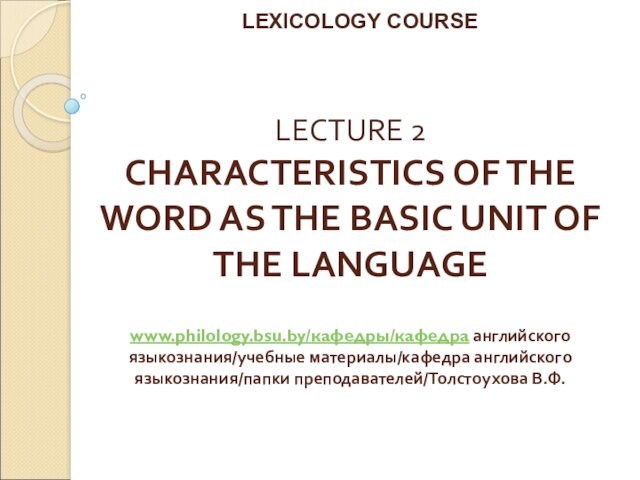
UNIT OF THE LANGUAGE
www.philology.bsu.by/кафедры/кафедра английского языкознания/учебные материалы/кафедра английского языкознания/папки
преподавателей/Толстоухова В.Ф.
LEXICOLOGY COURSE
Слайд 2
The questions under consideration
A word as a fundamental
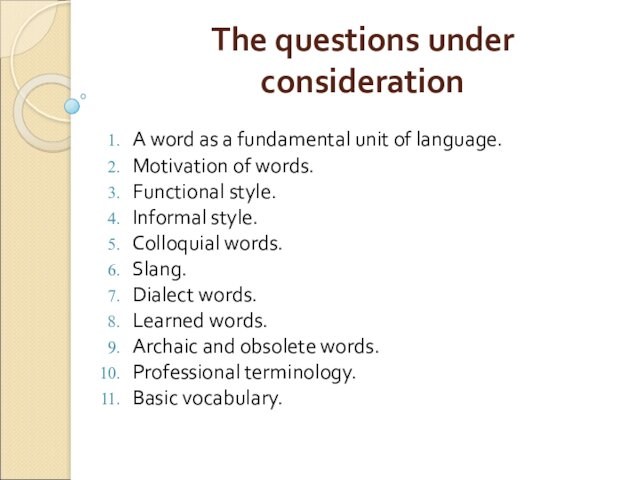
unit of language.
Motivation of words.
Functional style.
Informal style.
Colloquial words.
Slang.
Dialect words.
Learned
words.
Archaic and obsolete words.
Professional terminology.
Basic vocabulary.
Слайд 3
TEST 2
1. Give definitions to the following:
lexical system,
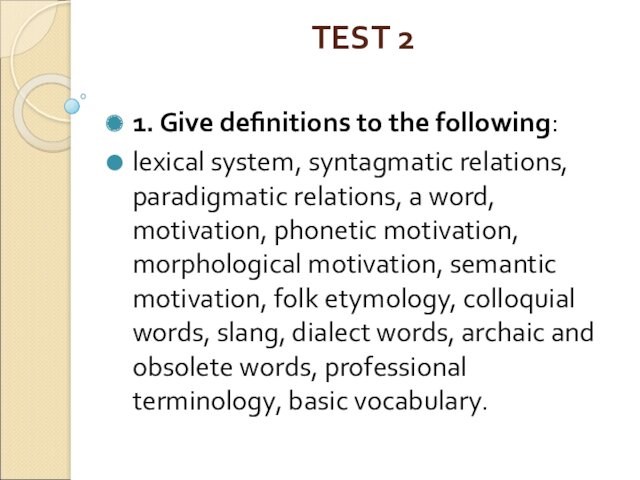
syntagmatic relations, paradigmatic relations, a word, motivation, phonetic motivation,
morphological motivation, semantic motivation, folk etymology, colloquial words, slang, dialect
words, archaic and obsolete words, professional terminology, basic vocabulary.
Слайд 4
Complete the following sentences using words and expressions
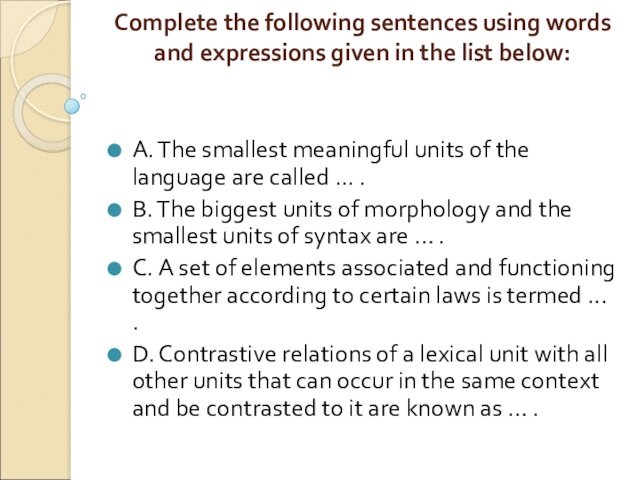
given in the list below:
A. The smallest meaningful
units of the language are called … .
B. The biggest
units of morphology and the smallest units of syntax are … .
С. A set of elements associated and functioning together according to certain laws is termed … .
D. Contrastive relations of a lexical unit with all other units that can occur in the same context and be contrasted to it are known as … .
Слайд 5
2.Complete the following sentences using words and expressions
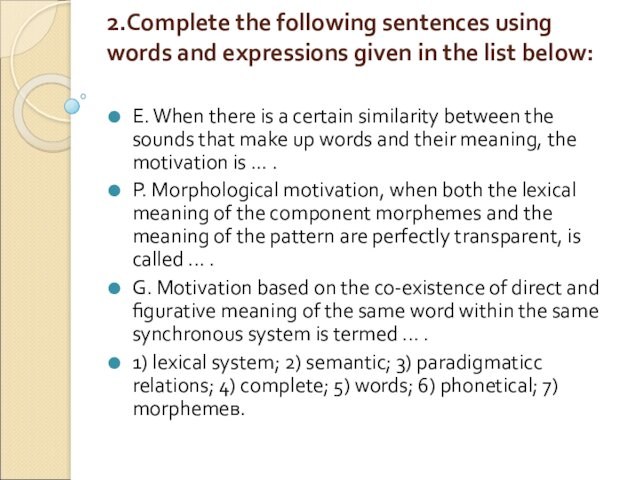
given in the list below:
E. When there is
a certain similarity between the sounds that make up words
and their meaning, the motivation is … .
P. Morphological motivation, when both the lexical meaning of the component morphemes and the meaning of the pattern are perfectly transparent, is called … .
G. Motivation based on the co-existence of direct and figurative meaning of the same word within the same synchronous system is termed … .
1) lexical system; 2) semantic; 3) paradigmaticс relations; 4) complete; 5) words; 6) phonetical; 7) morphemeв.
Слайд 6
3. Answer these questions
What determines the choice of
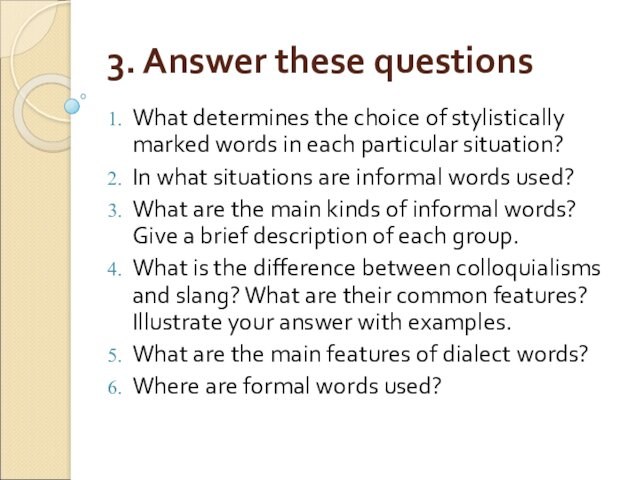
stylistically marked words in each particular situation?
In what situations
are informal words used?
What are the main kinds of informal
words? Give a brief description of each group.
What is the difference between colloquialisms and slang? What are their common features? Illustrate your answer with examples.
What are the main features of dialect words?
Where are formal words used?
Слайд 7
3. Answer these questions
Are learned words used only
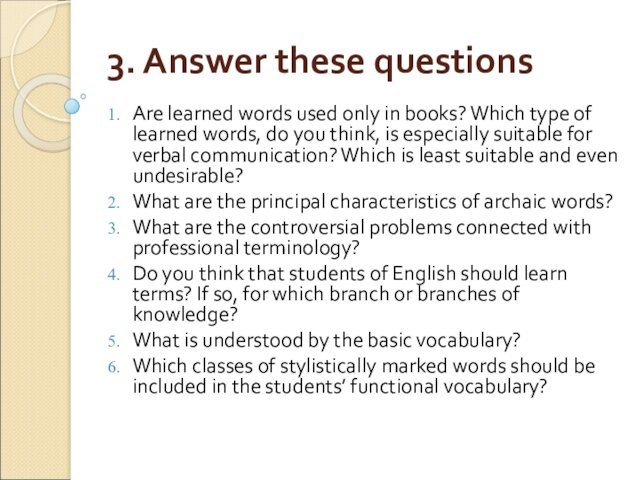
in books? Which type of learned words, do you
think, is especially suitable for verbal communication? Which is least
suitable and even undesirable?
What are the principal characteristics of archaic words?
What are the controversial problems connected with professional terminology?
Do you think that students of English should learn terms? If so, for which branch or branches of knowledge?
What is understood by the basic vocabulary?
Which classes of stylistically marked words should be included in the students’ functional vocabulary?
Слайд 8
1.A word as a fundamental unit of language.
The
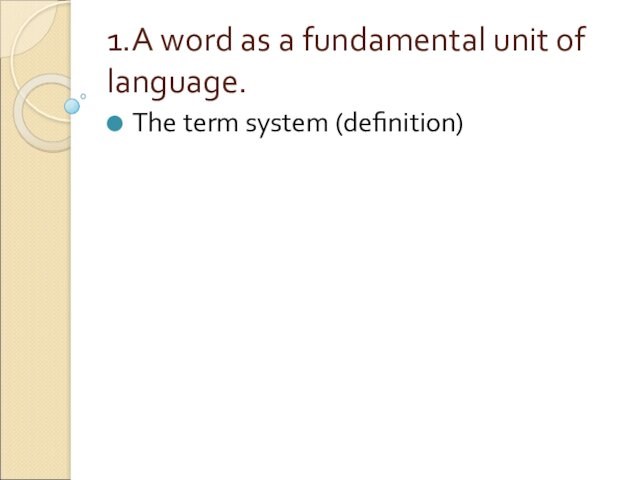
term system (definition)
Слайд 9
The term system
denotes a set of elements associated
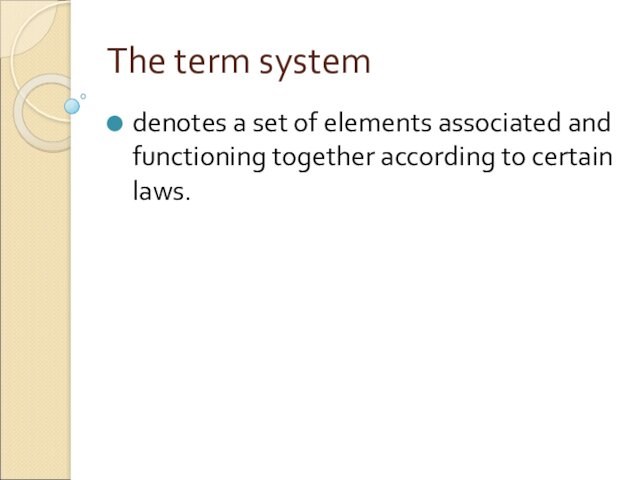
and functioning together according to certain laws.
Слайд 10
The lexical system of every epoch
contains
productive
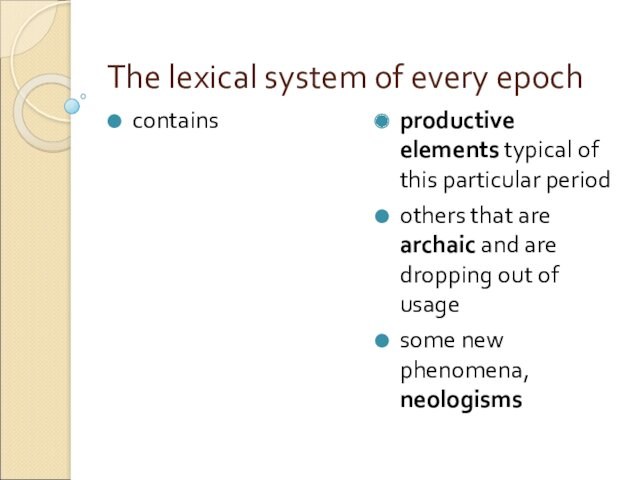
elements typical of this particular period
others that are
archaic and are dropping out of usage
some new phenomena,
neologisms
Слайд 11
The elements of lexical system
are characterized
by their combinatorial
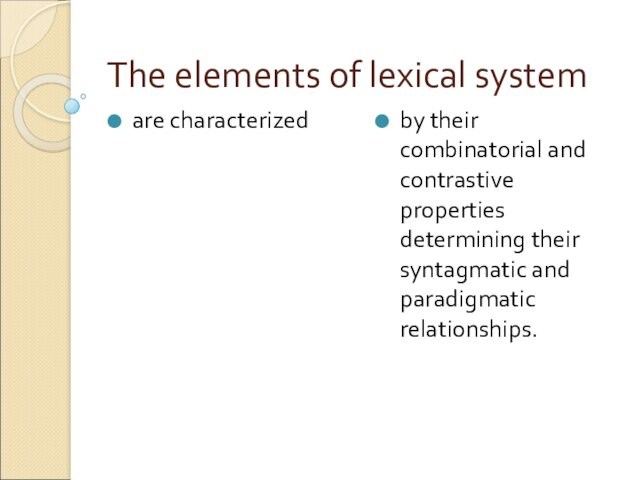
and contrastive properties determining their syntagmatic and paradigmatic relationships.
Слайд 12
EXAMPLE
compare the meaning of the verb «to get»
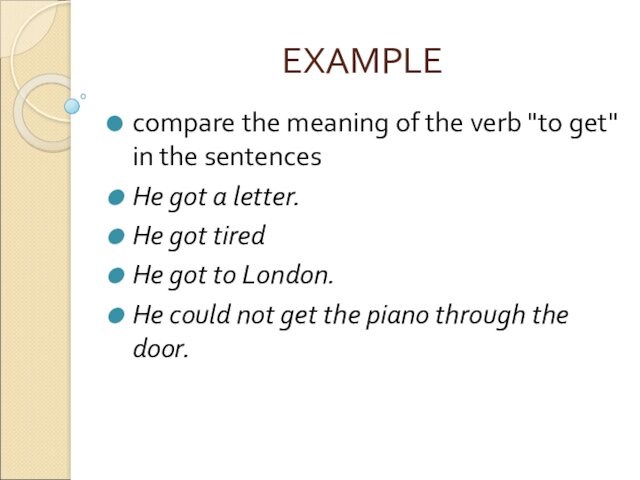
in the sentences
He got a letter.
He got
tired
He got to London.
He could not get the piano through
the door.
Слайд 13
On the syntagmatic level,
the semantic structure of
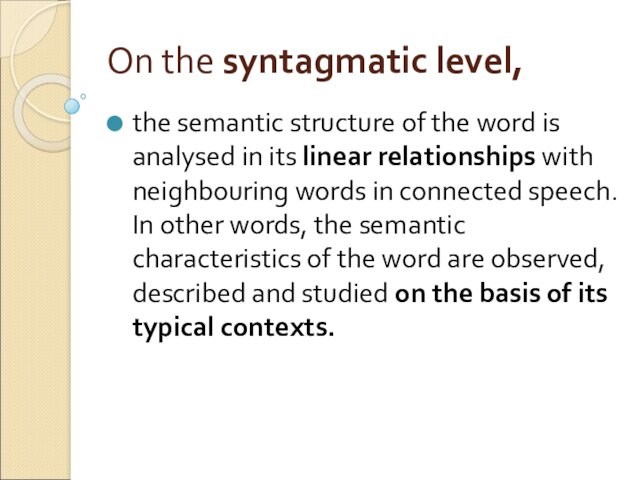
the word is analysed in its linear relationships with
neighbouring words in connected speech. In other words, the semantic
characteristics of the word are observed, described and studied on the basis of its typical contexts.
Слайд 14
Paradigmatic contrastive relations
Where do they exist ?
Example:
to go
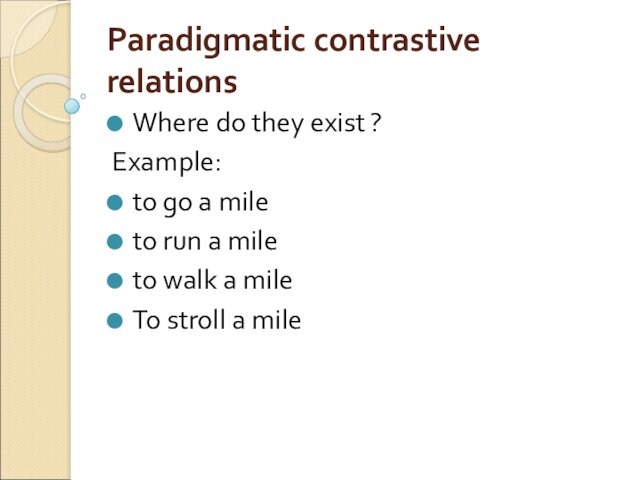
a mile
to run a mile
to walk a
mile
To stroll a mile
Слайд 15
Paradigmatic contrastive relations
exist between words belonging to
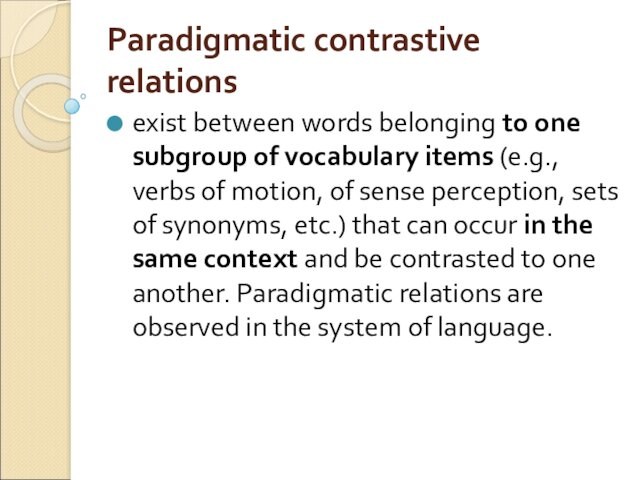
one subgroup of vocabulary items (e.g., verbs of motion,
of sense perception, sets of synonyms, etc.) that can occur
in the same context and be contrasted to one another. Paradigmatic relations are observed in the system of language.
Слайд 16
On the paradigmatic level
the word is studied
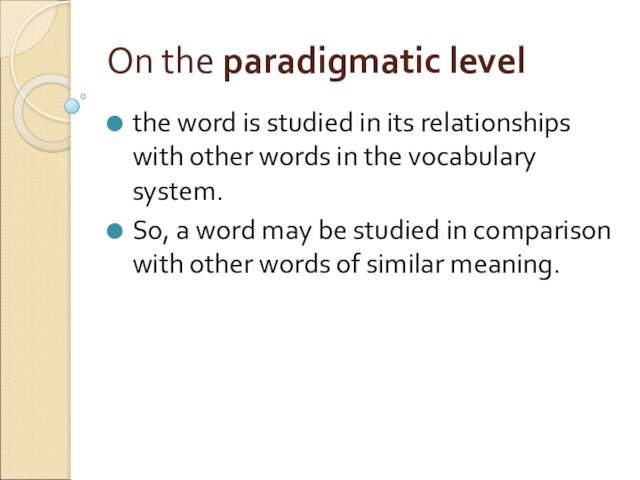
in its relationships with other words in the vocabulary
system.
So, a word may be studied in comparison with
other words of similar meaning.
Слайд 17
work n – labour n.
Work работа, труд;
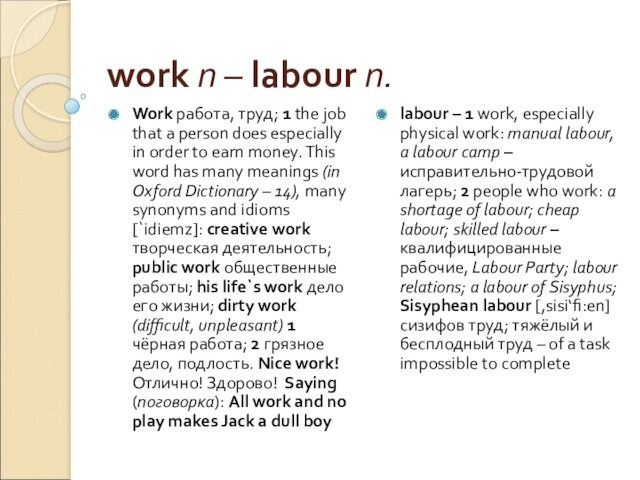
1 the job that a person does especially in
order to earn money. This word has many meanings (in
Oxford Dictionary – 14), many synonyms and idioms [`idiemz]: creative work творческая деятельность; public work общественные работы; his life`s work дело его жизни; dirty work (difficult, unpleasant) 1 чёрная работа; 2 грязное дело, подлость. Nice work! Отлично! Здорово! Saying (поговорка): All work and no play makes Jack a dull boy
labour – 1 work, especially physical work: manual labour, a labour camp – исправительно-трудовой лагерь; 2 people who work: a shortage of labour; cheap labour; skilled labour – квалифицированные рабочие, Labour Party; labour relations; a labour of Sisyphus; Sisyphean labour [,sisi‘fi:en] сизифов труд; тяжёлый и бесплодный труд – of a task impossible to complete
Слайд 18
On the paradigmatic level
words of similar meaning
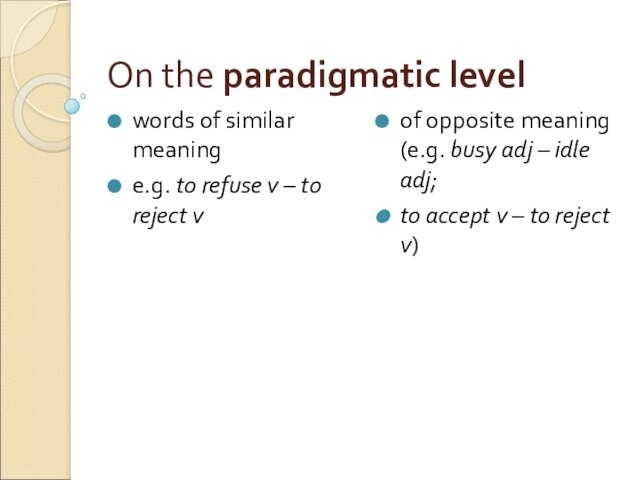
e.g. to refuse v – to reject v
of
opposite meaning (e.g. busy adj – idle adj;
to accept
v – to reject v)
Слайд 19
On the paradigmatic level
of different stylistic characteristics
(e.g.
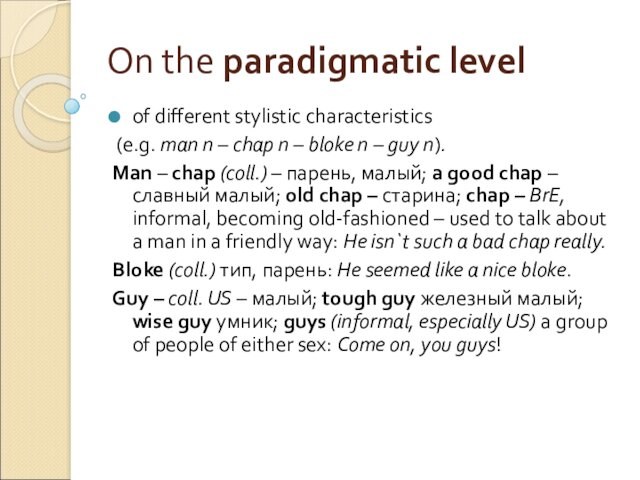
man n – chap n – bloke n –
guy n).
Man – chap (coll.) – парень, малый; a
good chap – славный малый; old chap – старина; chap – BrE, informal, becoming old-fashioned – used to talk about a man in a friendly way: He isn`t such a bad chap really.
Bloke (coll.) тип, парень: He seemed like a nice bloke.
Guy – coll. US – малый; tough guy железный малый; wise guy умник; guys (informal, especially US) a group of people of either sex: Come on, you guys!
Слайд 20
The main problems of paradigmatic studies
are synonymy,
antonymy,
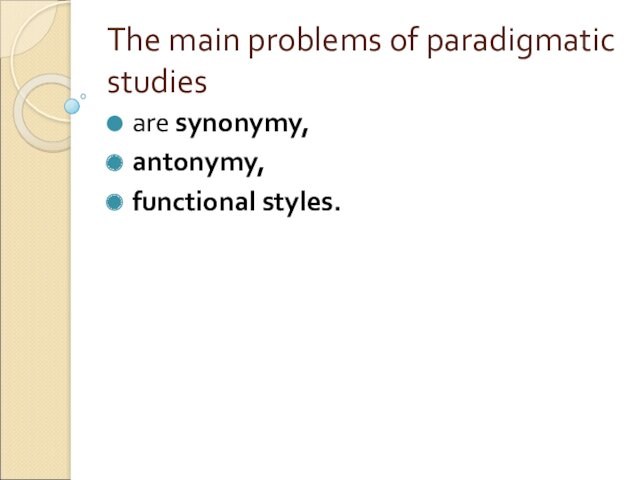
functional styles.
Слайд 21
Words vs Morphemes
the central elements of language
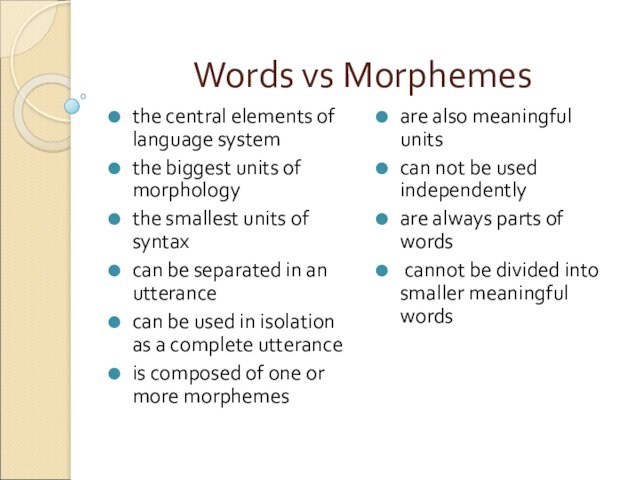
system
the biggest units of morphology
the smallest units
of syntax
can be separated in an utterance
can be
used in isolation as a complete utterance
is composed of one or more morphemes
are also meaningful units
can not be used independently
are always parts of words
cannot be divided into smaller meaningful words
Слайд 22
Why is the definition of a word
the most
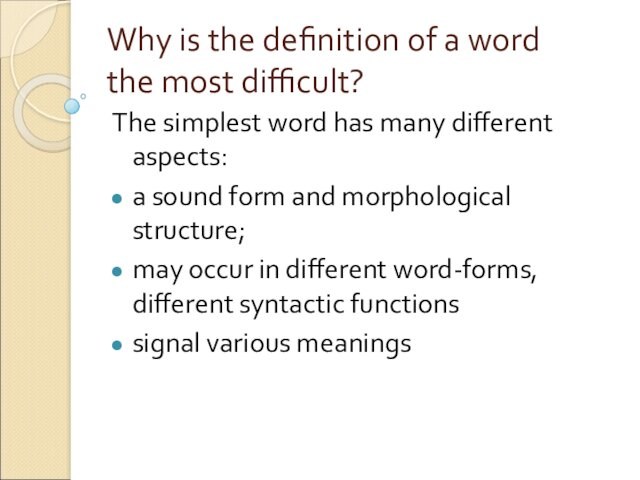
difficult?
The simplest word has many different aspects:
a sound
form and morphological structure;
may occur in different word-forms, different
syntactic functions
signal various meanings
Слайд 23
Why is the definition of a word
the most
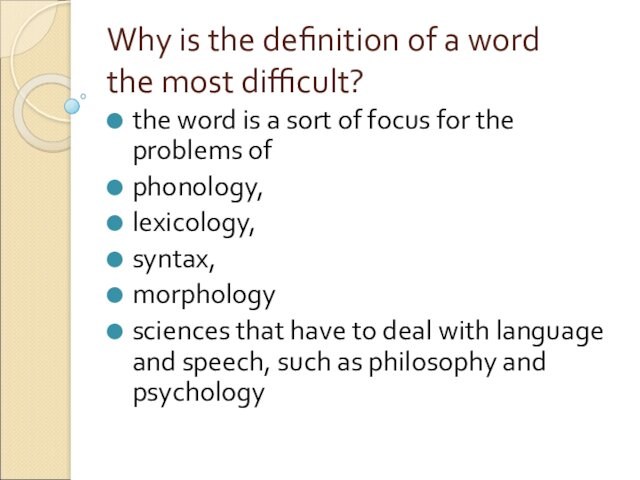
difficult?
the word is a sort of focus for the
problems of
phonology,
lexicology,
syntax,
morphology
sciences that have to
deal with language and speech, such as philosophy and psychology
Слайд 24
The definition of a word
The word has been
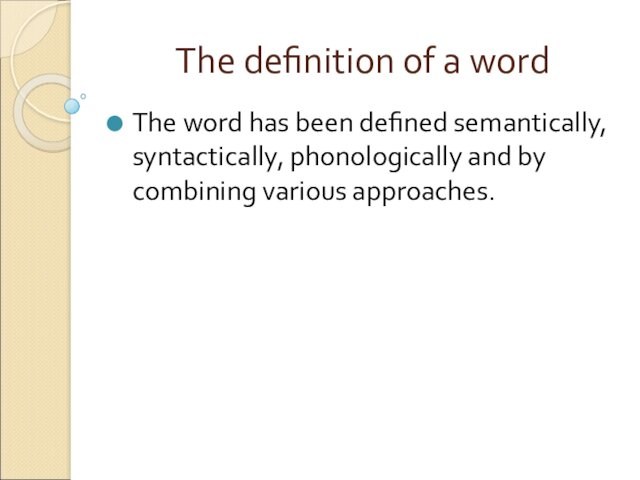
defined semantically, syntactically, phonologically and by combining various approaches.
Слайд 25
The definition of a word
Many eminent scholars such
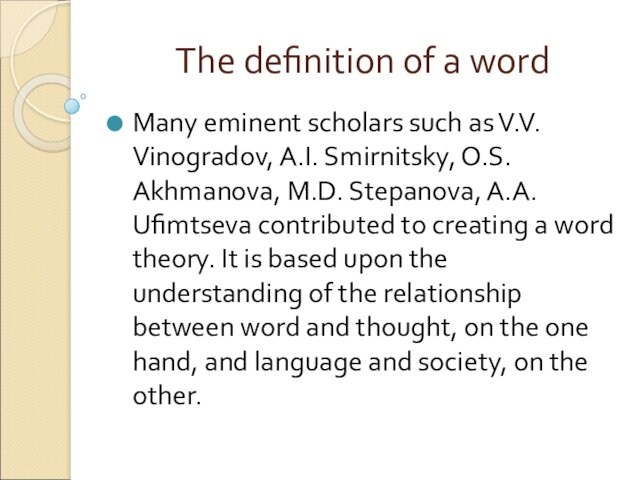
as V.V. Vinogradov, A.I. Smirnitsky, O.S. Akhmanova, M.D. Stepanova,
A.A. Ufimtseva contributed to creating a word theory. It is
based upon the understanding of the relationship between word and thought, on the one hand, and language and society, on the other.
Слайд 26
The definition of a word
A word is the
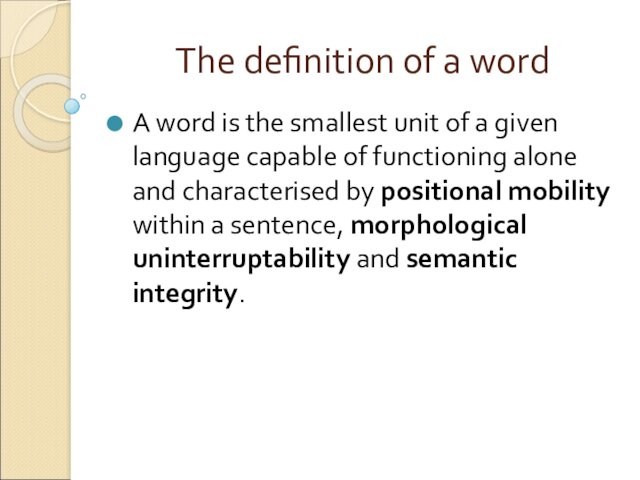
smallest unit of a given language capable of functioning
alone and characterised by positional mobility within a sentence, morphological
uninterruptability and semantic integritу.
Слайд 27
The definition of a word
«a word is defined
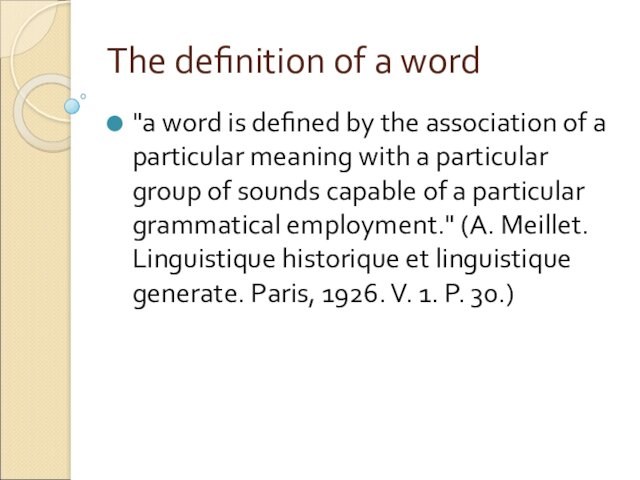
by the association of a particular meaning with a
particular group of sounds capable of a particular grammatical employment.»
(A. Meillet. Linguistique historique et linguistique generate. Paris, 1926. V. 1. P. 30.)
Слайд 28
2. Motivation of words.
The term mоtivation is used
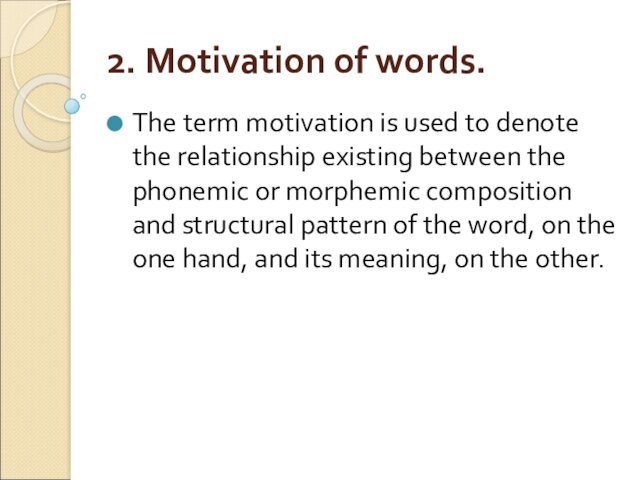
to denote the relationship existing between the phonemic or
morphemic composition and structural pattern of the word, on the
one hand, and its meaning, on the other.
Слайд 29
Three types of motivation
phonetical motivation,
morphological motivation
semantic
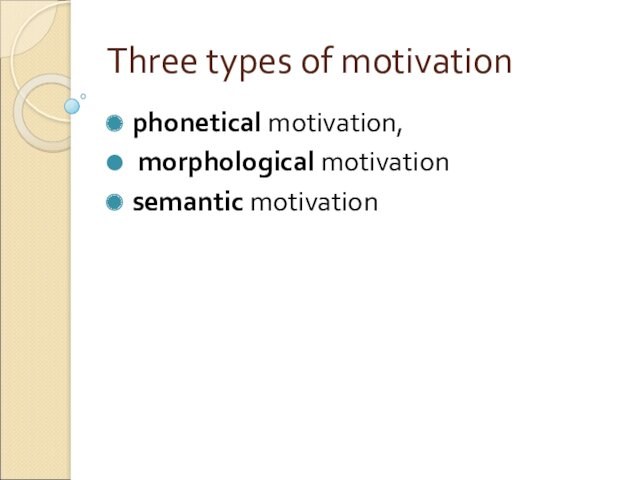
motivation
Слайд 30
What motivation is it?
e.g., bump,
buzz,
chatter,
clatter,
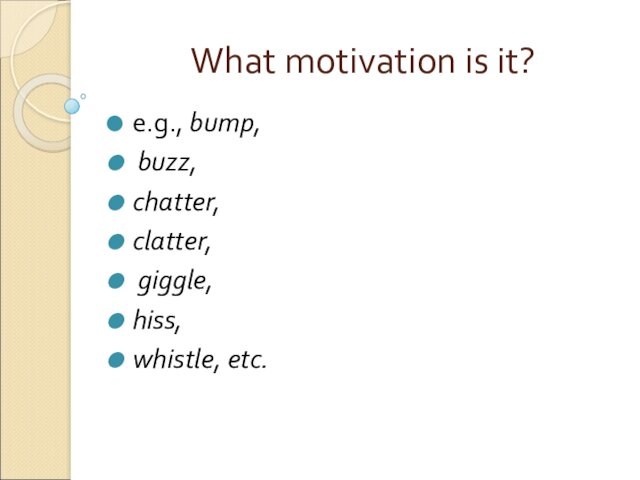
giggle,
hiss,
whistle, etc.
Слайд 31
The phonetical motivation is
when there is a certain
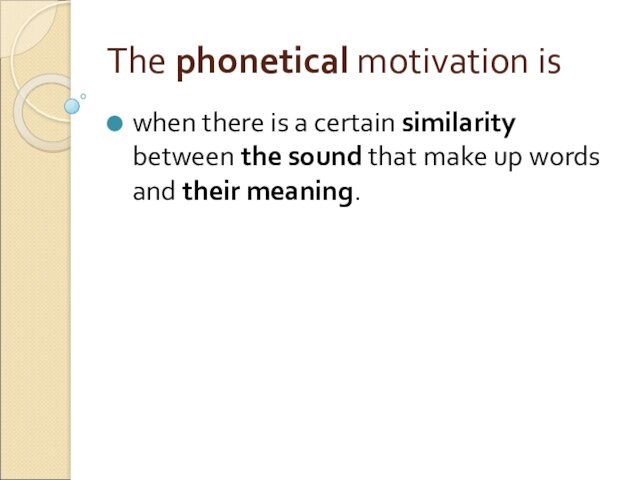
similarity between the sound that make up words and
their meaning.
Слайд 32
morphological motivation
The main criterion in morphological motivation
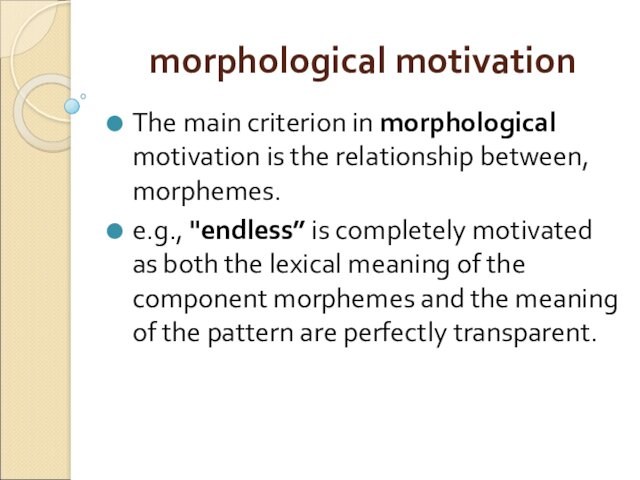
is the relationship between, morphemes.
e.g., «endless” is completely
motivated as both the lexical meaning of the component morphemes
and the meaning of the pattern are perfectly transparent.
Слайд 33
morphological motivation
«cranberry» is only partially motivated because of;
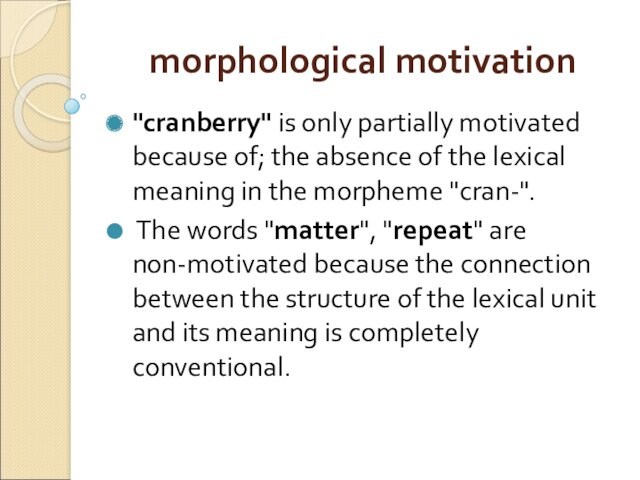
the absence of the lexical meaning in the morpheme
«cran-«.
The words «matter», «repeat» are non-motivated because the connection
between the structure of the lexical unit and its meaning is completely conventional.
Слайд 34
Semantiс motivation
is based on the co-existence of direct
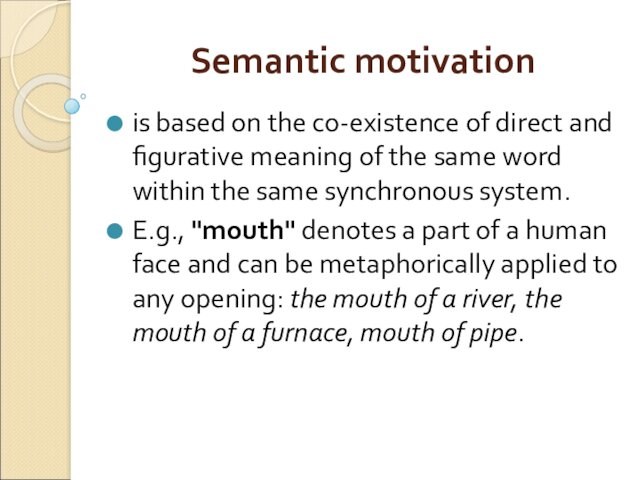
and figurative meaning of the same word within the
same synchronous system.
E.g., «mouth» denotes a part of a
human face and can be metaphorically applied to any opening: the mouth of a river, the mouth of a furnace, mouth of pipe.
Слайд 35
Semantiс motivation
Semantic motivation is clear in popular names
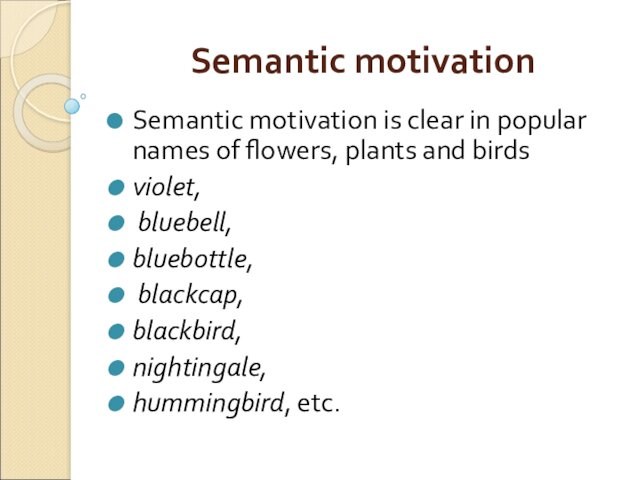
of flowers, plants and birds
violet,
bluebell,
bluebottle,
blackcap,
blackbird,
nightingale,
hummingbird, etc.
Слайд 36
Semantiс motivation
As to compounds their motivation is morphological
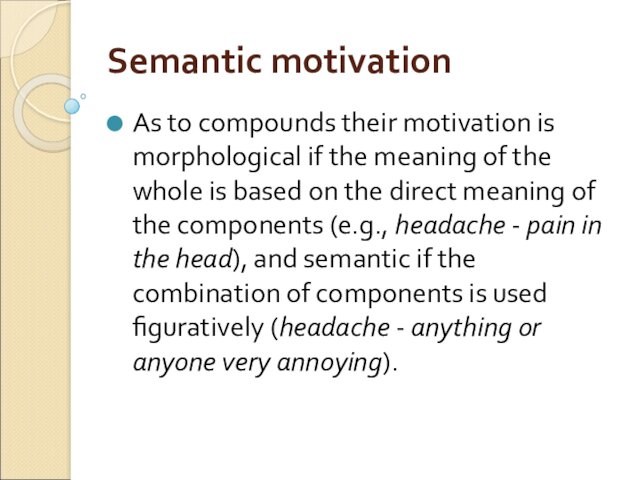
if the meaning of the whole is based on
the direct meaning of the components (e.g., headache — pain
in the head), and semantic if the combination of components is used figuratively (headache — anything or anyone very annoying).
Слайд 37
fоlk etуmоlogy (popular etymology, false etymology)
E.g. «mushroom”
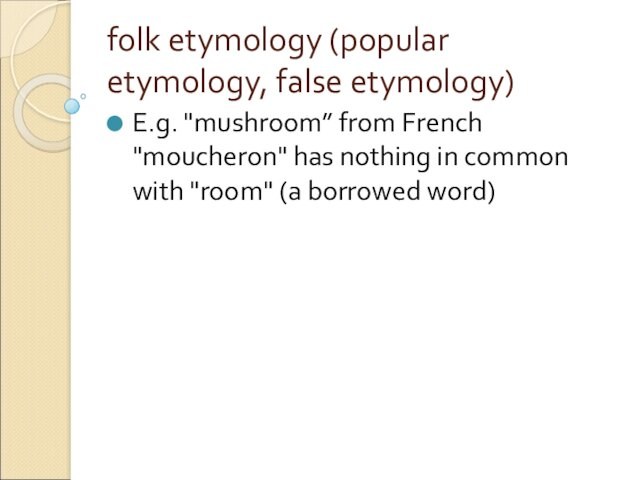
from French «moucheron» has nothing in common with «room»
(a borrowed word)
Слайд 38
3. Functional style (definition)
”a system of expressive means
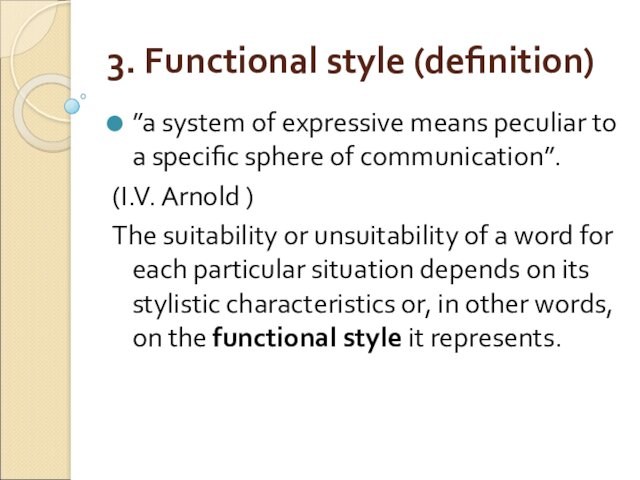
peculiar to a specific sphere of communication”.
(I.V. Arnold )
The
suitability or unsuitability of a word for each particular situation
depends on its stylistic characteristics or, in other words, on the functional style it represents.
Слайд 39
Functional style (definition)
A system of expressive means peculiar
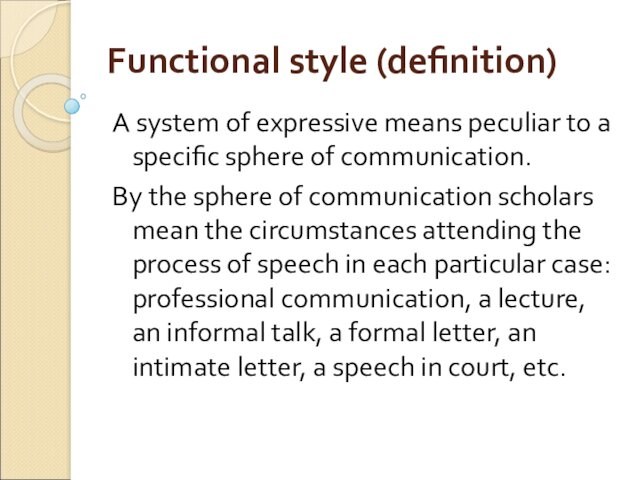
to a specific sphere of communication.
By the sphere of
communication scholars mean the circumstances attending the process of speech
in each particular case: professional communication, a lecture, an informal talk, a formal letter, an intimate letter, a speech in court, etc.
Слайд 40
Subdivisions of spheres of communications
formal (a lecture, a
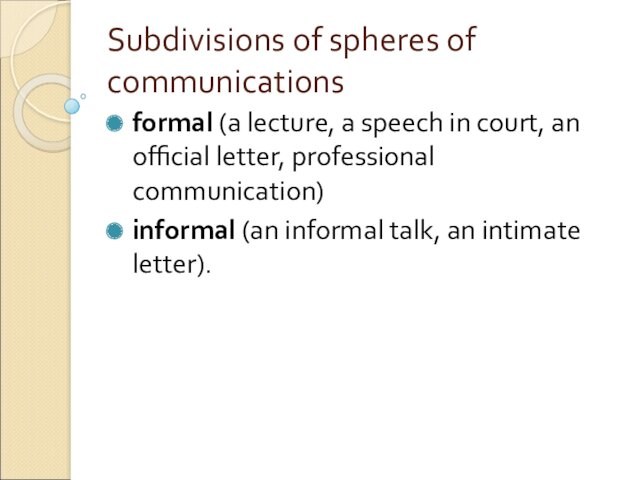
speech in court, an official letter, professional communication)
informal
(an informal talk, an intimate letter).
Слайд 41
4. Informal style (where?)
Informal vocabulary is used in
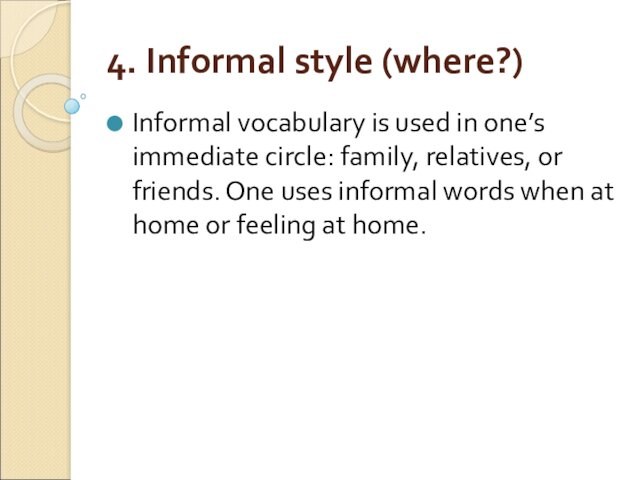
one’s immediate circle: family, relatives, or friends. One uses
informal words when at home or feeling at home.
Слайд 42
Informal style (characteristics)
relaxed,
free-and-easy
familiar
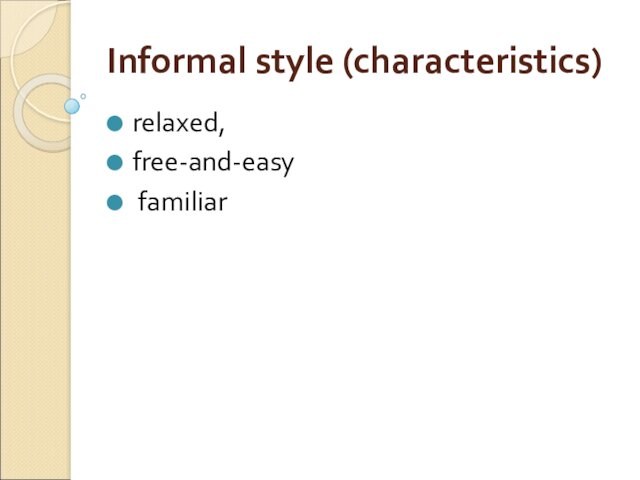
Слайд 43
the informal talk differs
well-educated people
adults (the choice
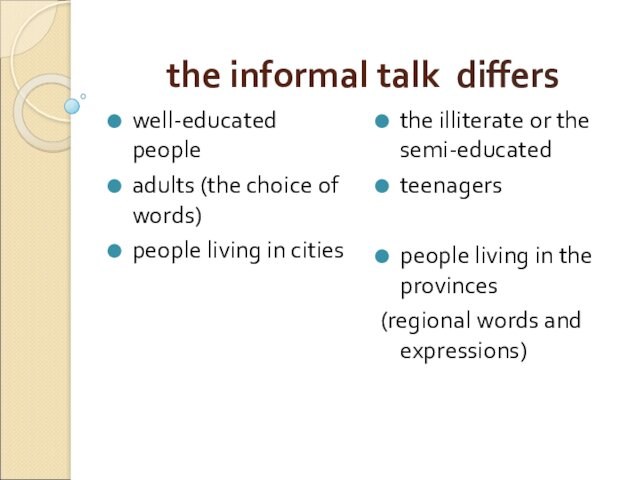
of words)
people living in cities
the illiterate or the semi-educated
teenagers
people living in the provinces
(regional words and expressions)
Слайд 44
The choice of words
is determined not only
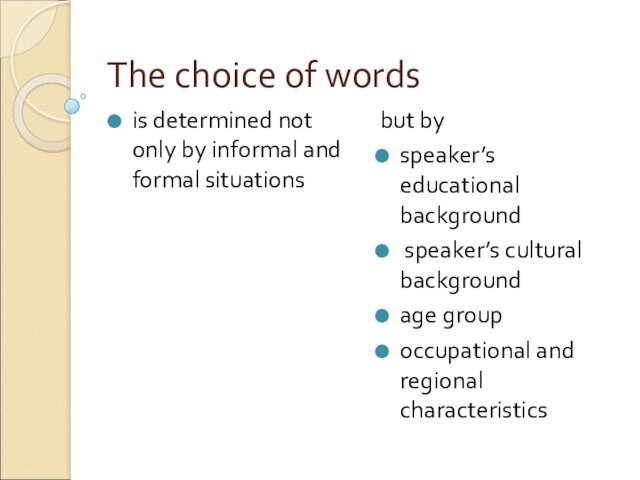
by informal and formal situations
but by
speaker’s educational background
speaker’s
cultural background
age group
occupational and regional characteristics
Слайд 45
three types of informal words
colloquial
slang
dialect

words and word-groups
Слайд 46
5. Colloquial words
(Where? By whom?)
in everyday conversational speech
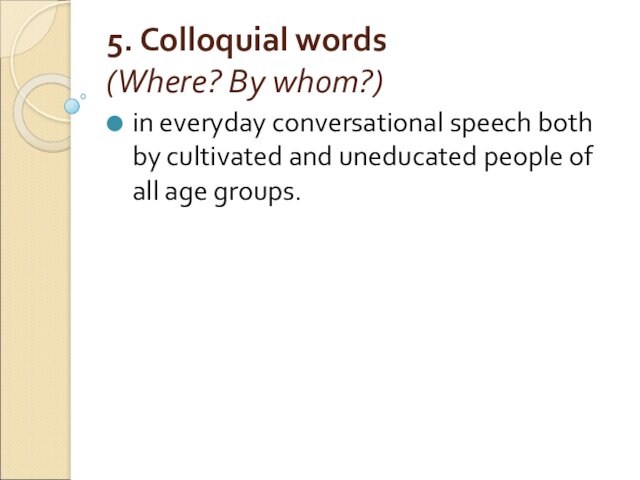
both by cultivated and uneducated people of all age
groups.
Слайд 47
literary colloquial words
appear in dialogues in which
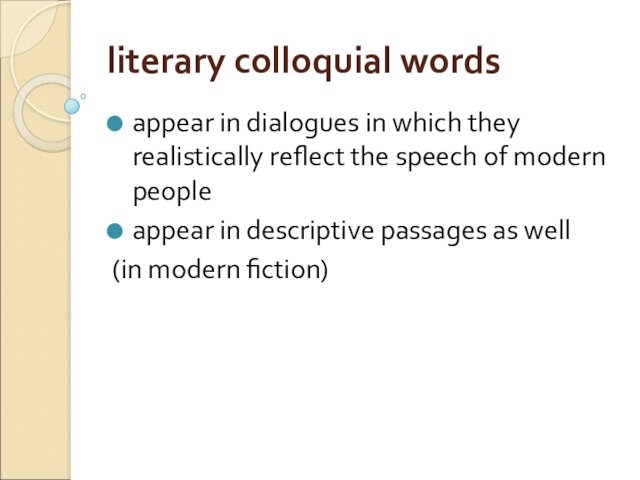
they realistically reflect the speech of modern people
appear
in descriptive passages as well
(in modern fiction)
Слайд 48
examples of literary colloquial words
Pal (кореш, друг)
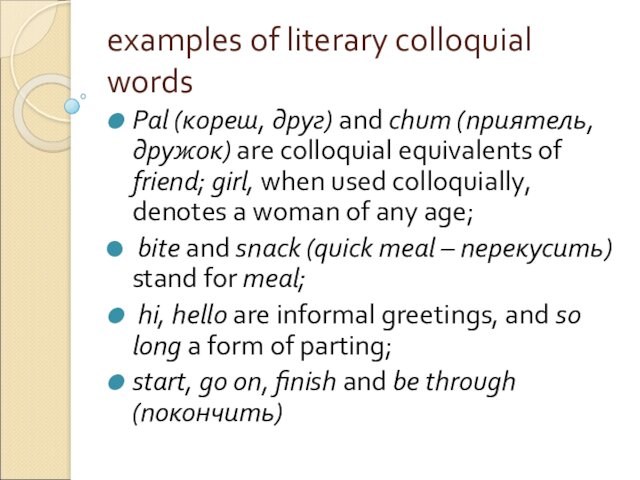
and chum (приятель, дружок) are colloquial equivalents of friend;
girl, when used colloquially, denotes a woman of any age;
bite and snack (quick meal – перекусить) stand for meal;
hi, hello are informal greetings, and so long a form of parting;
start, go on, finish and be through (покончить)
Слайд 49
examples of literary colloquial words
A considerable number of
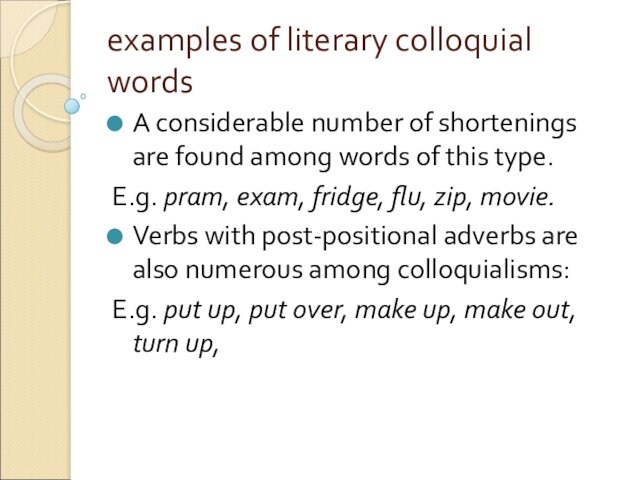
shortenings are found among words of this type.
E.g.
pram, exam, fridge, flu, zip, movie.
Verbs with post-positional adverbs are
also numerous among colloquialisms:
E.g. put up, put over, make up, make out, turn up,
Слайд 50
literary colloquial words (are to be distinguished from)
familiar
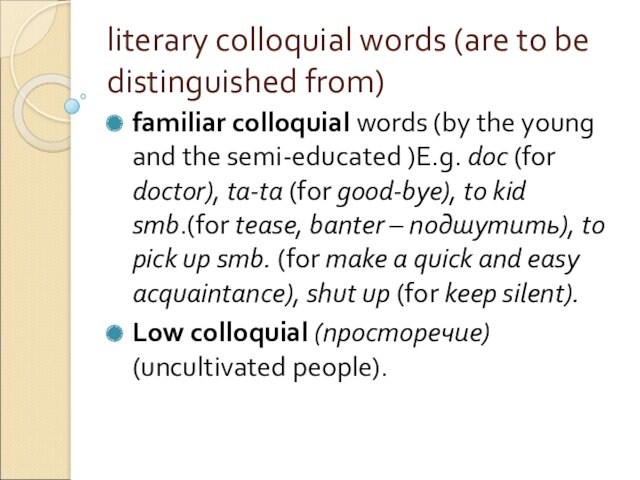
colloquial words (by the young and the semi-educated )E.g.
doc (for doctor), ta-ta (for good-bye), to kid smb.(for tease,
banter – подшутить), to pick up smb. (for make a quick and easy acquaintance), shut up (for keep silent).
Low colloquial (просторечие) (uncultivated people).
Слайд 51
6.Slang
The Oxford English Dictionary defines slang as “language
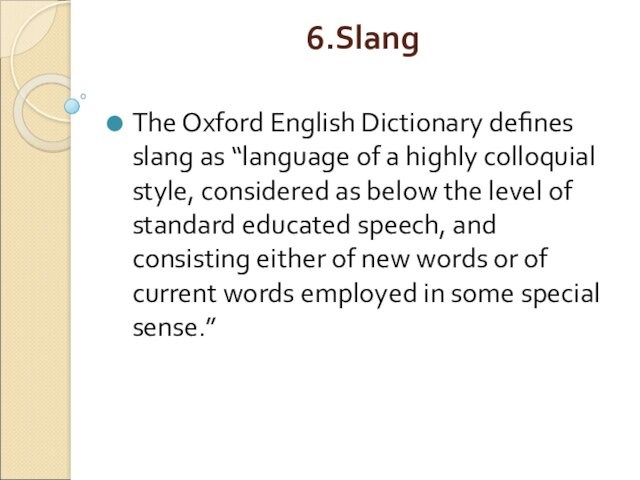
of a highly colloquial style, considered as below the
level of standard educated speech, and consisting either of new
words or of current words employed in some special sense.”
Слайд 52
Slang
All or most slang words are current words
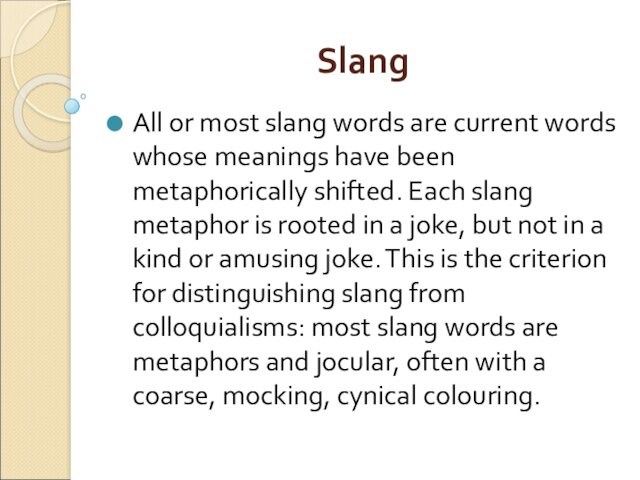
whose meanings have been metaphorically shifted. Each slang metaphor
is rooted in a joke, but not in a kind
or amusing joke. This is the criterion for distinguishing slang from colloquialisms: most slang words are metaphors and jocular, often with a coarse, mocking, cynical colouring.
Слайд 53
Slang (the main reasons to use?)
To be picturesque,
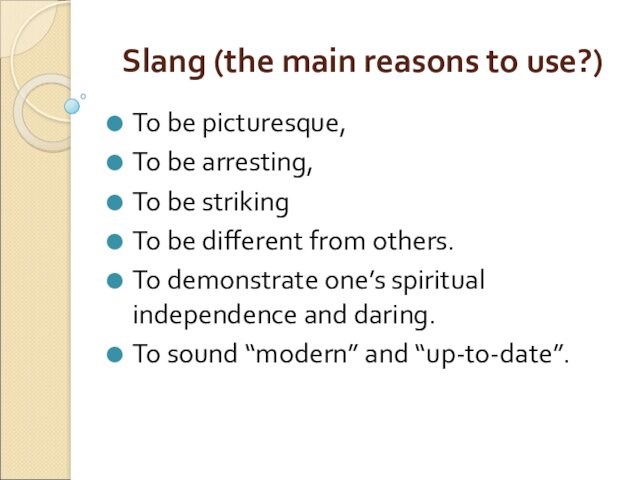
To be arresting,
To be striking
To be different
from others.
To demonstrate one’s spiritual independence and daring.
To
sound “modern” and “up-to-date”.
Слайд 54
Slang (who are users?)
The circle of users
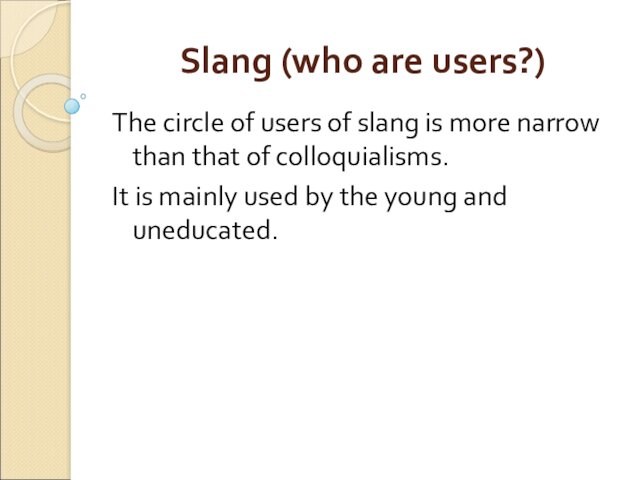
of slang is more narrow than that of colloquialisms.
It is mainly used by the young and uneducated.
Слайд 55
7.Dialect words
dialects are regional forms of English
Dialect
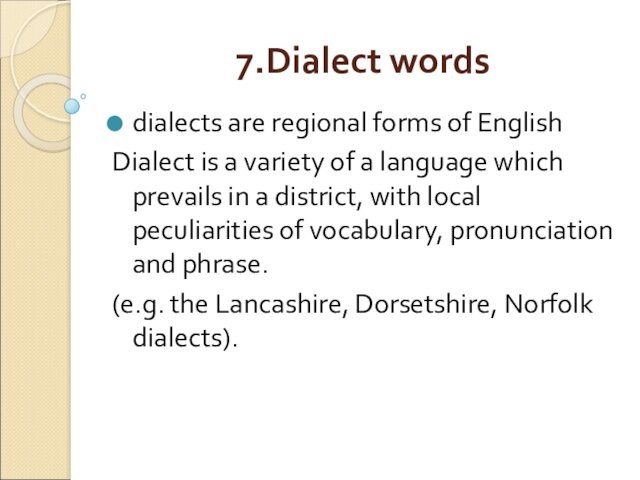
is a variety of a language which prevails in
a district, with local peculiarities of vocabulary, pronunciation and phrase.
(e.g. the Lancashire, Dorsetshire, Norfolk dialects).
Слайд 56
Dialect words are constantly being incorporated into
everyday colloquial
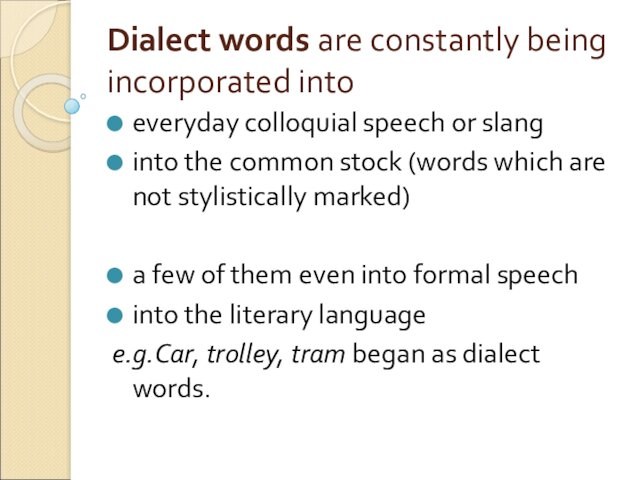
speech or slang
into the common stock (words which
are not stylistically marked)
a few of them even into
formal speech
into the literary language
e.g.Car, trolley, tram began as dialect words.
Слайд 57
Dialect words (examples)
tha (thee) – the objective case
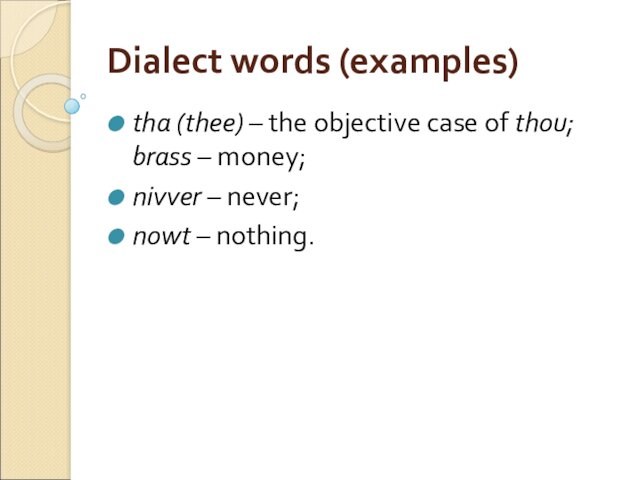
of thou; brass – money;
nivver – never;
nowt
– nothing.
Слайд 58
8. Learned words (two main groups):
words associated with
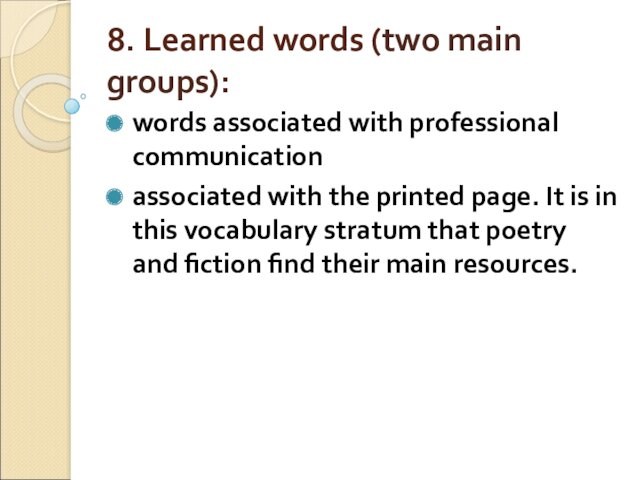
professional communication
associated with the printed page. It is
in this vocabulary stratum that poetry and fiction find their
main resources.
Слайд 59
Learned words (further subdivision)
We find here numerous words
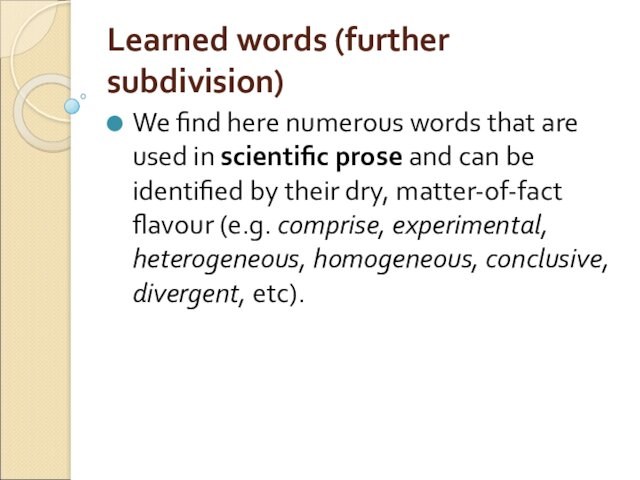
that are used in scientific prose and can be
identified by their dry, matter-of-fact flavour (e.g. comprise, experimental, heterogeneous,
homogeneous, conclusive, divergent, etc).
Слайд 60
Learned words
‘officialese’ (канцеляризмы). These are the words of
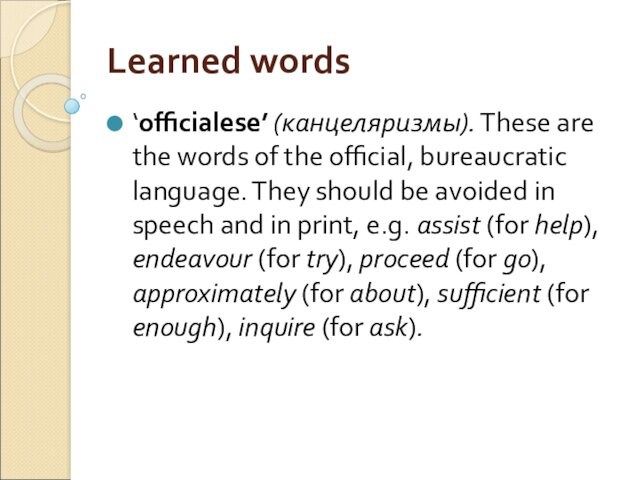
the official, bureaucratic language. They should be avoided in
speech and in print, e.g. assist (for help), endeavour (for
try), proceed (for go), approximately (for about), sufficient (for enough), inquire (for ask).
Слайд 61
Learned words (further subdivision)
the words found in descriptive
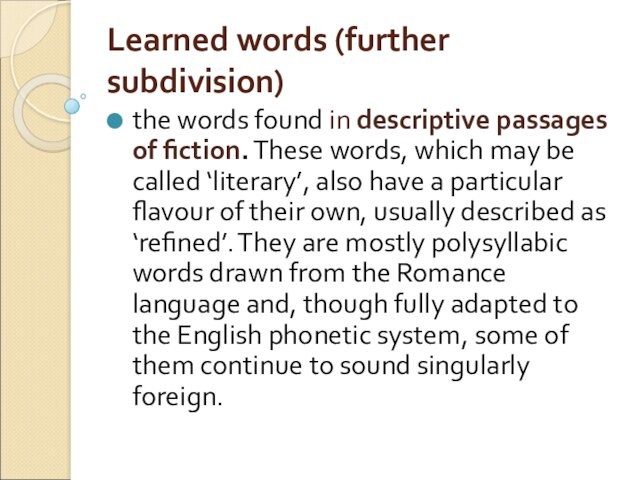
passages of fiction. These words, which may be called
‘literary’, also have a particular flavour of their own, usually
described as ‘refined’. They are mostly polysyllabic words drawn from the Romance language and, though fully adapted to the English phonetic system, some of them continue to sound singularly foreign.
Слайд 62
Learned words
Here are some examples: solitude=loneless, lonely place
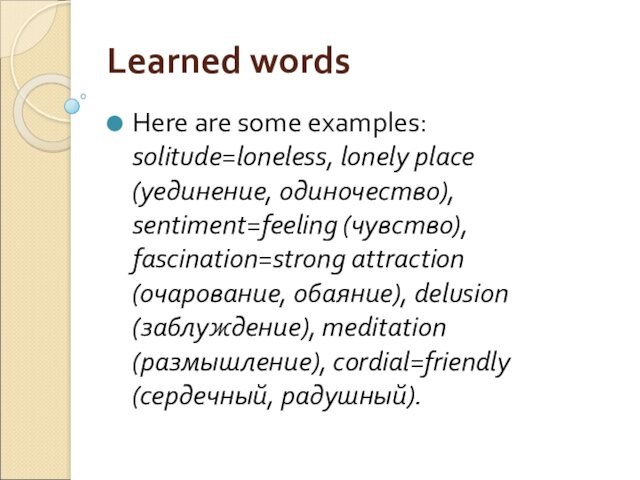
(уединение, одиночество), sentiment=feeling (чувство), fascination=strong attraction (очарование, обаяние), delusion
(заблуждение), meditation (размышление), cordial=friendly (сердечный, радушный).
Слайд 63
Learned words (further subdivision)
There is one further subdivision
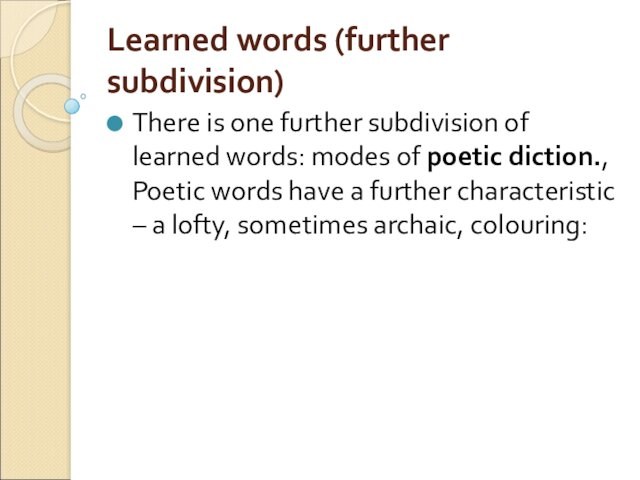
of learned words: modes of poetic diction., Poetic words
have a further characteristic – a lofty, sometimes archaic, colouring:
Слайд 64
Examples of poetic words
“Alas! (увы) they had been
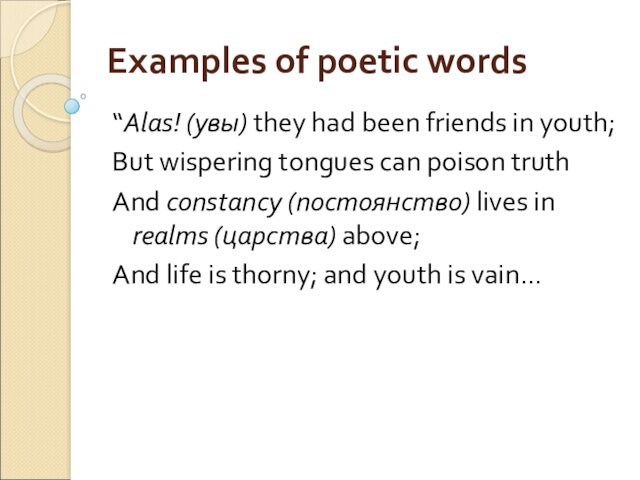
friends in youth;
But wispering tongues can poison truth
And constancy
(постоянство) lives in realms (царства) above;
And life is thorny; and
youth is vain…
Слайд 65
Learned words (not only in printed page)
Though learned
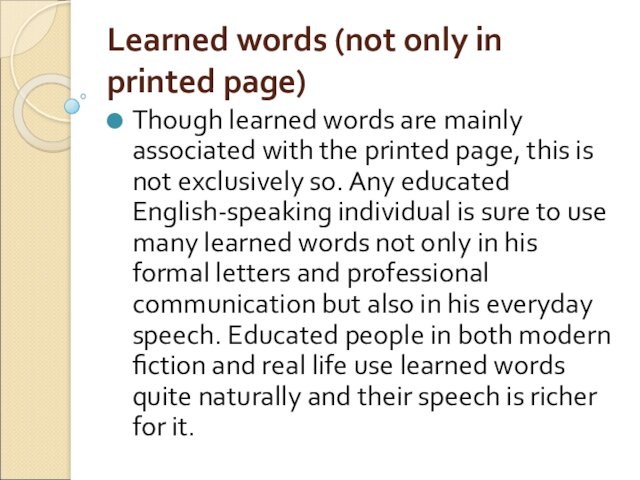
words are mainly associated with the printed page, this
is not exclusively so. Any educated English-speaking individual is sure
to use many learned words not only in his formal letters and professional communication but also in his everyday speech. Educated people in both modern fiction and real life use learned words quite naturally and their speech is richer for it.
Слайд 66
Learned words
But on the other hand, utterances overloaded
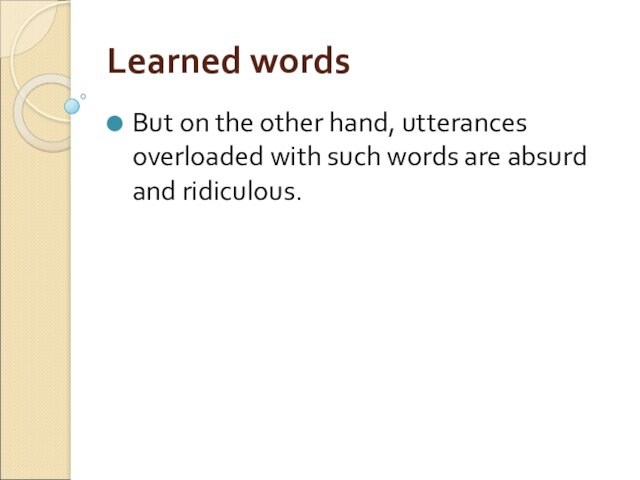
with such words are absurd and ridiculous.
Слайд 67
Learned words and Writers
Writers use this phenomenon
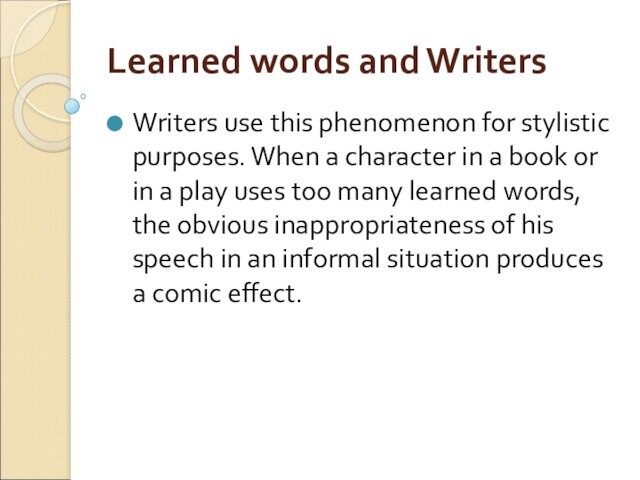
for stylistic purposes. When a character in a book
or in a play uses too many learned words, the
obvious inappropriateness of his speech in an informal situation produces a comic effect.
Слайд 68
Learned words
However any suggestion that learned words are
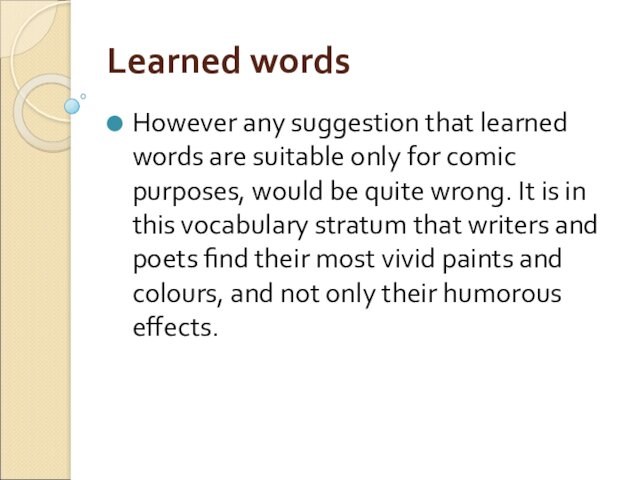
suitable only for comic purposes, would be quite wrong.
It is in this vocabulary stratum that writers and poets
find their most vivid paints and colours, and not only their humorous effects.
Слайд 69
Learned words
It is also true that some of
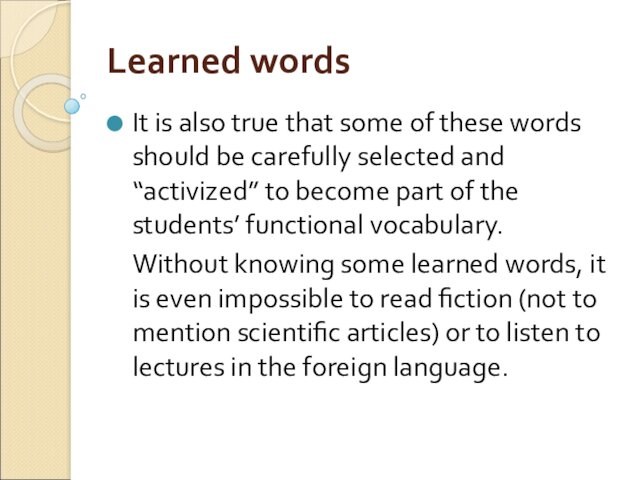
these words should be carefully selected and “activized” to
become part of the students’ functional vocabulary.
Without knowing some learned
words, it is even impossible to read fiction (not to mention scientific articles) or to listen to lectures in the foreign language.
Слайд 70
9.Archaic and obsolete words
Archaic – are old and
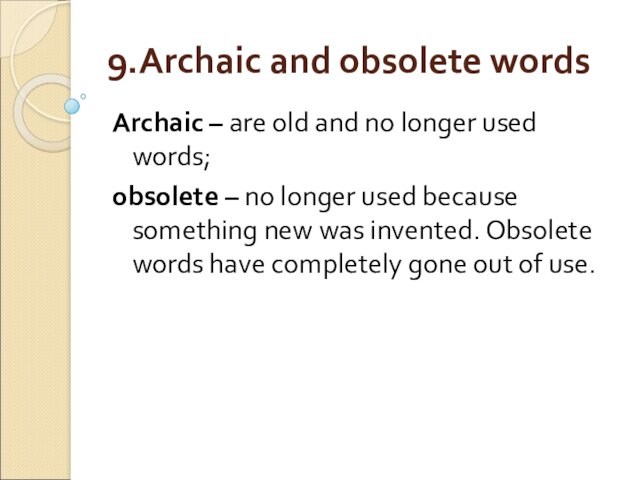
no longer used words;
obsolete – no longer used
because something new was invented. Obsolete words have completely gone
out of use.
Слайд 71
Archaic words
are restricted to the printed page. These
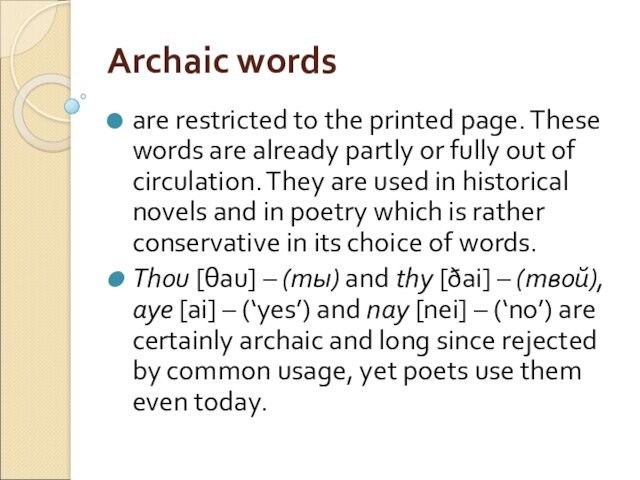
words are already partly or fully out of circulation.
They are used in historical novels and in poetry which
is rather conservative in its choice of words.
Thou [θаu] – (ты) and thy [ðai] – (твой), aye [ai] – (‘yes’) and nay [nei] – (‘no’) are certainly archaic and long since rejected by common usage, yet poets use them even today.
Слайд 72
Archaic words
Numerous archaisms can be found in Shakespeare,
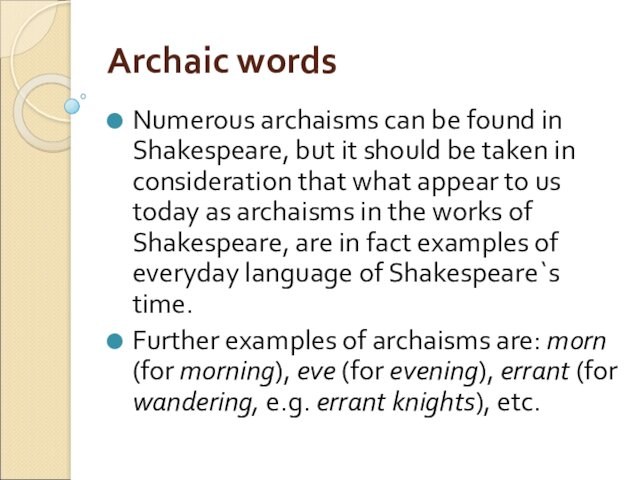
but it should be taken in consideration that what
appear to us today as archaisms in the works of
Shakespeare, are in fact examples of everyday language of Shakespeare`s time.
Further examples of archaisms are: morn (for morning), eve (for evening), errant (for wandering, e.g. errant knights), etc.
Слайд 73
Archaic words
Sometimes an archaic word may undergo a
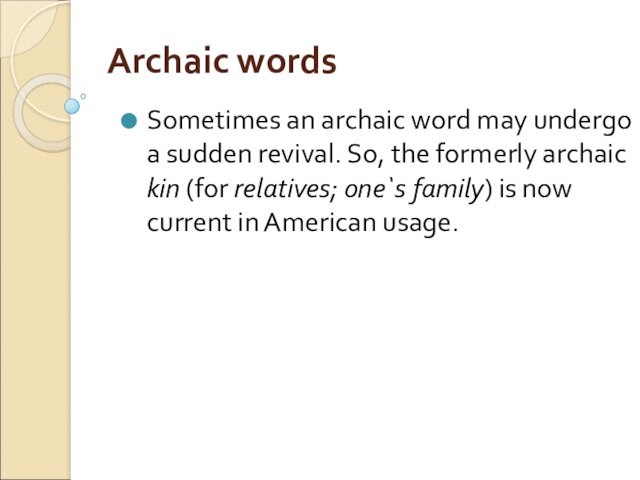
sudden revival. So, the formerly archaic kin (for relatives;
one`s family) is now current in American usage.
Слайд 74
10.Professional terminology
Every field of modern activity has its
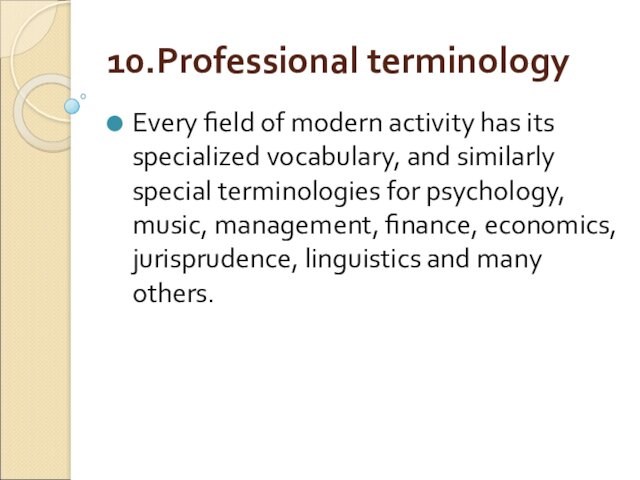
specialized vocabulary, and similarly special terminologies for psychology, music,
management, finance, economics, jurisprudence, linguistics and many others.
Слайд 75
Professional terminology
Term, as traditionally understood, is a word
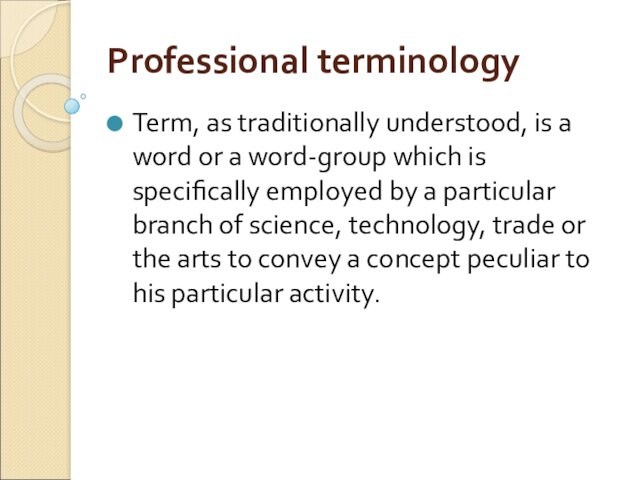
or a word-group which is specifically employed by a
particular branch of science, technology, trade or the arts to
convey a concept peculiar to his particular activity.
Слайд 76
Professional terminology
So, share, bank, balance sheet are finance
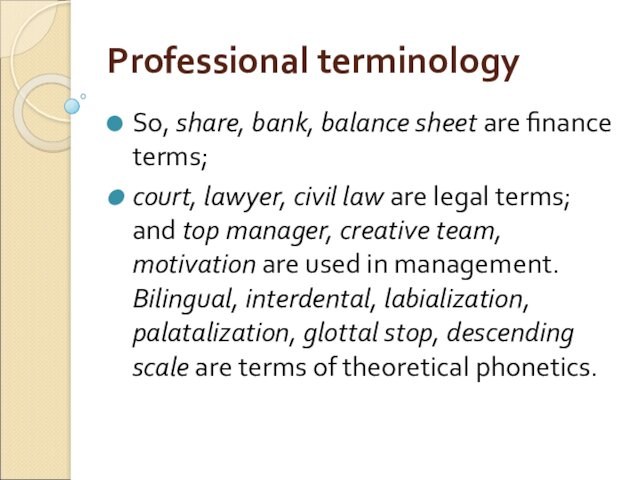
terms;
court, lawyer, civil law are legal terms; and
top manager, creative team, motivation are used in management. Bilingual,
interdental, labialization, palatalization, glottal stop, descending scale are terms of theoretical phonetics.
Слайд 77
controversial problems in the field of terminology.
a
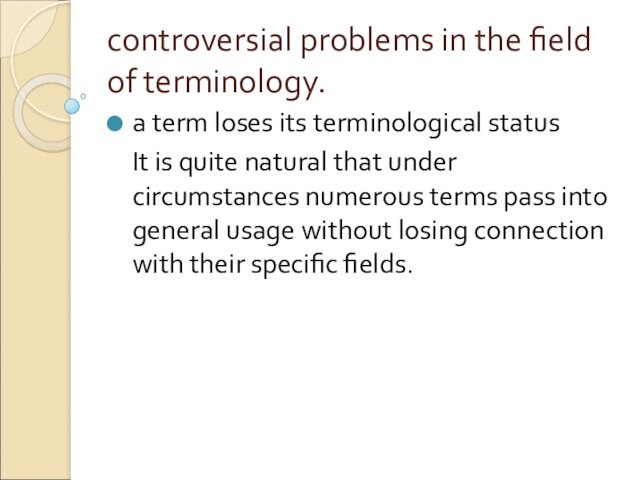
term loses its terminological status
It is quite natural
that under circumstances numerous terms pass into general usage without
losing connection with their specific fields.
Слайд 78
Professional terminology
There are linguists in whose opinion terms
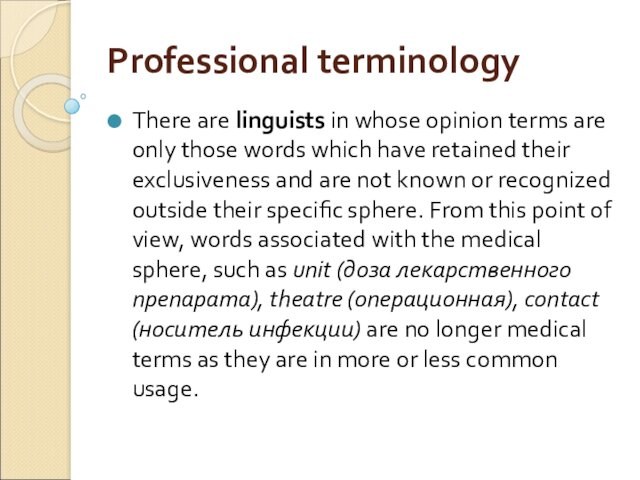
are only those words which have retained their exclusiveness
and are not known or recognized outside their specific sphere.
From this point of view, words associated with the medical sphere, such as unit (доза лекарственного препарата), theatre (операционная), contact (носитель инфекции) are no longer medical terms as they are in more or less common usage.
Слайд 79
Professional terminology
There is yet another point of view,
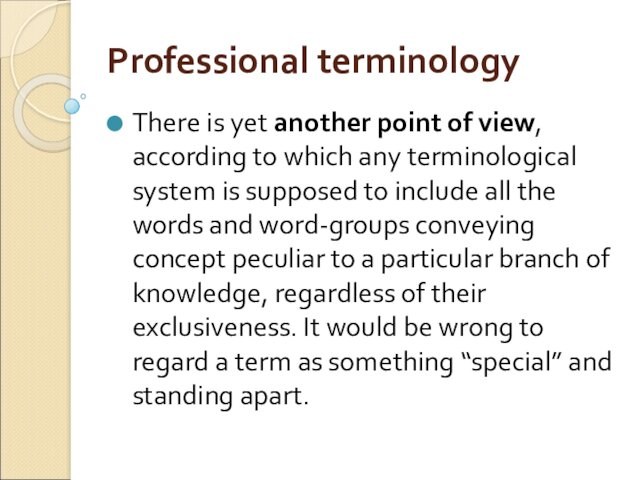
according to which any terminological system is supposed to
include all the words and word-groups conveying concept peculiar to
a particular branch of knowledge, regardless of their exclusiveness. It would be wrong to regard a term as something “special” and standing apart.
Слайд 80
polysemy and synonymy
According to some linguists, an
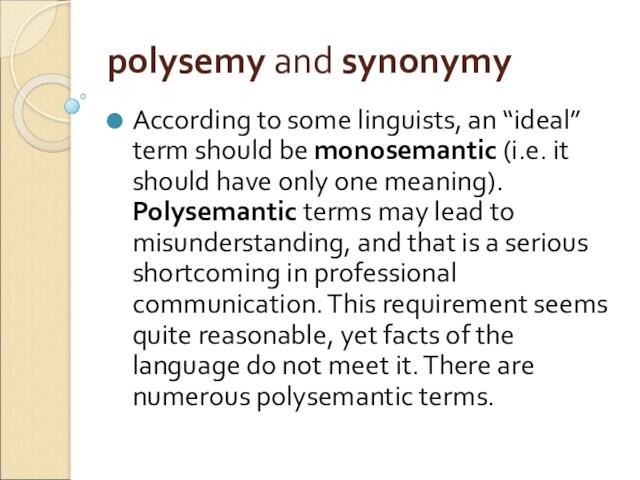
“ideal” term should be monosemantic (i.e. it should have
only one meaning). Polysemantic terms may lead to misunderstanding, and
that is a serious shortcoming in professional communication. This requirement seems quite reasonable, yet facts of the language do not meet it. There are numerous polysemantic terms.
Слайд 81
synonymy
The same is true about synonymy in terminological
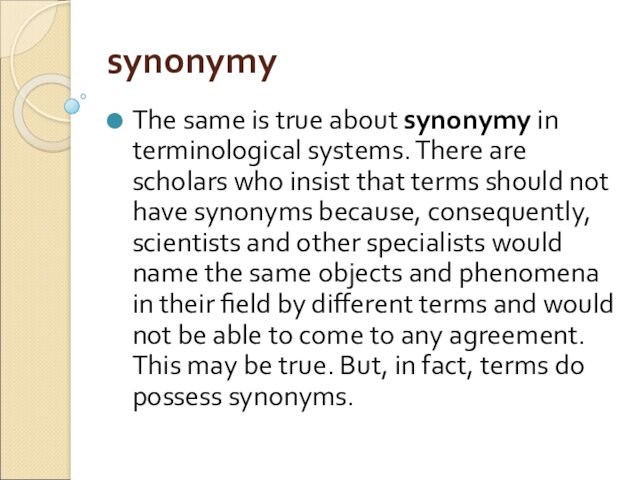
systems. There are scholars who insist that terms should
not have synonyms because, consequently, scientists and other specialists would
name the same objects and phenomena in their field by different terms and would not be able to come to any agreement. This may be true. But, in fact, terms do possess synonyms.
Слайд 82
10.Basic vocabulary
are stylistically neutral,
used them in all

kinds of situations, both formal and informal, in verbal
and written communication
are used every day, everywhere and by
everybody, regardless of profession, occupation, educational level, age group or geographical location.
Слайд 83
Basic vocabulary
without them no human communication would be
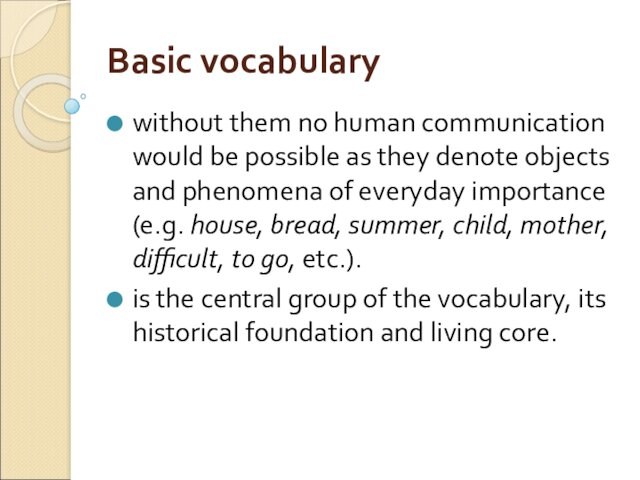
possible as they denote objects and phenomena of everyday
importance (e.g. house, bread, summer, child, mother, difficult, to go,
etc.).
is the central group of the vocabulary, its historical foundation and living core.
Слайд 84
Basic vocabulary
Basic vocabulary words can be recognized not
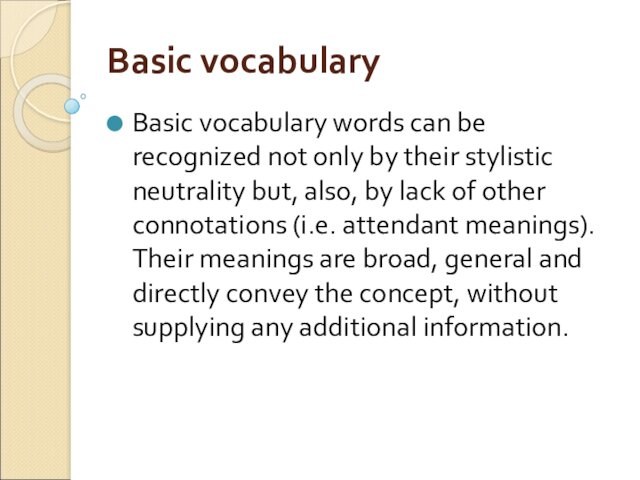
only by their stylistic neutrality but, also, by lack
of other connotations (i.e. attendant meanings). Their meanings are broad,
general and directly convey the concept, without supplying any additional information.
Слайд 85
Basic vocabulary
For instance, the verb to walk means
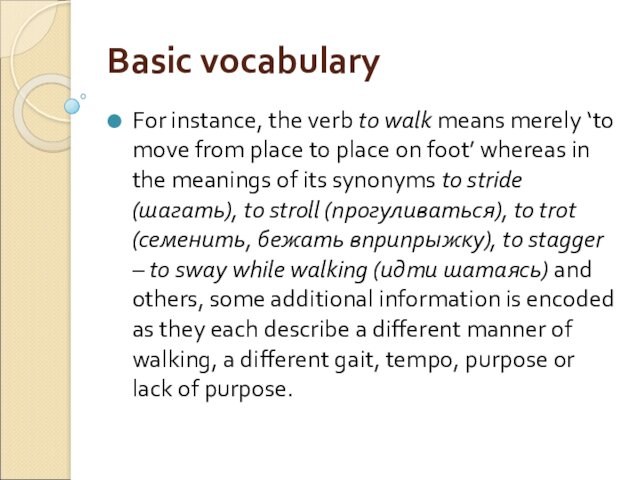
merely ‘to move from place to place on foot’
whereas in the meanings of its synonyms to stride (шагать),
to stroll (прогуливаться), to trot (семенить, бежать вприпрыжку), to stagger – to sway while walking (идти шатаясь) and others, some additional information is encoded as they each describe a different manner of walking, a different gait, tempo, purpose or lack of purpose.
Слайд 86
Basic vocabulary
Basic vocabulary 1.begin, 2.continue 3.end 4.child, baby
Informal
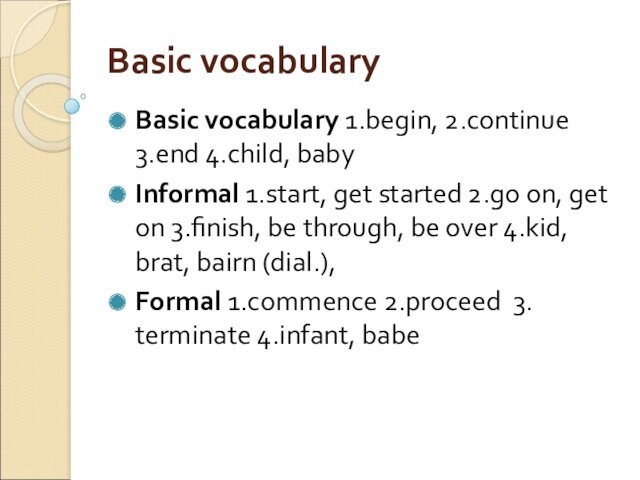
1.start, get started 2.go on, get on 3.finish, be
through, be over 4.kid, brat, bairn (dial.),
Formal 1.commence 2.proceed 3.
terminate 4.infant, babe
Скачать материал

Скачать материал


- Сейчас обучается 396 человек из 63 регионов


- Сейчас обучается 268 человек из 64 регионов




Описание презентации по отдельным слайдам:
-
1 слайд
Word as the basic unit of language
Lecture 2. -
2 слайд
§ 1. The Definition of the Word
A successful definition should 1) contain essential features of a word and 2) draw a sharp borderline between various linguistic units:
1.1. word and phoneme (Oh! I)
1.2. word and morpheme (man, wise, ism)
1.3. word and phrase (all right, alarm clock, the reciprocal pronouns each other and one another) -
3 слайд
1.1. Unity of form and meaning
Word — Formphonetic/graphic morphological structure grammar form
Essential features
Word – Meaningdenotational connotational lexico-grammatic grammatic
-
4 слайд
1.2. When used in sentences words are syntactically organized. Their freedom of entering into syntactic constructions is limited by rules and constraints
They told me this story vs. They spoke me this story
to deny smth categorically vs. to admit categorically1.3. Words are characterized by (in)ability to occur in different situations
In a business letter: ‘I was a bit put out to hear that you are not going to place the order with us’
To a friend: ‘I regret to inform you that our meeting will have to be postponed. -
5 слайд
Distinctive features: Within the scope of linguistics the word has been defined syntactically, semantically, phonologically and by combining various approaches.
Syntactic: H. Sweet «the minimum sentence“
L. Bloomfield «a minimum free form».
Syntactic and semantic aspects:
E. Sapir — «one of the smallest completely satisfying bits of isolated ‘meaning’, into which the sentence resolves itself. It cannot be cut into without a disturbance of meaning”.
Indivisibility criterion: A lion is a word-group because we can insert other words between them: a living lion. Alive is a word: it is indivisible, nothing can be inserted between its elements.
Semantic:
Stephen Ullmann: “words are meaningful units.» -
6 слайд
Semantic-phonological approach:
A.H.Gardiner: «A word is an articulate sound-symbol in its aspect of denoting something which is spoken about.»
Thus, a satisfying word-definition should reflect the following features as borrowed from the above explanations:
the association of a particular meaning with a particular group of sounds
capable of a particular grammatical employment
the smallest significant unit, used in isolation
capable of functioning alone
characterized by morphological uninterruptability and
having semantic integrity -
7 слайд
§ 2. Types of lexical units
The units/elements of a vocabulary are lexical units, which means that they are two-facet elements possessing form and meaning.
Set expressions or groups of words into which words may be combined
Morphemes which are parts of words, into which words may be analyzed
They are, apart from words: -
8 слайд
Morphemes are structural units which either form a new word or modify its meaning. Their meaning is of more abstract and general nature. Morphemes can’t function alone and deny grammar change.
Set expressions are word groups consisting of two or more words whose combination is integrated so that they are introduced in speech ready-made as units with a specialized meaning of the whole that is not understood as a mere sum total of the meanings of the elements.
-
9 слайд
are the biggest units of morphology and the smallest of syntax
embody the main structural properties and functions of the language (nominative, significative, communicative and pragmatic)
can be used in isolation
are thought of as having a single referent or represent a concept, a feeling, an action
are the smallest units of written discourse: they are marked off by solid spelling
segmentation of a sentence into words is easily done by an illiterate speaker, but that of a word into morphemes presents sometimes difficulties even for trained linguists
are written as a sequence of letters bounded by spaces on a page (with exceptions)
Wоrds are the central elements of language system = we speak in words and not otherwise, because they : -
10 слайд
Thus, the vocabulary of a language is not homogeneous, it’s made of sets with blurred boundaries
WORDS
morphemes
set expressions
phrasal verbs
adaptive abstract system
selective reflection
Syntagmatic and paradigmatic relations
Functional vs. referential approach -
11 слайд
§ 3. Types of words
Eight Kinds of Words by Tom McArthur:The orthographic word
(a visual sign with space around: colour vs. color)
The phonological word
(a spoken signal: a notion vs. an ocean)
The morphological word
(a unity behind variants of form
The lexical word
(lexeme, full word as related to a thing, action or state in the world) -
12 слайд
The grammatical word
(form word, a closed set of conj-s, determiners, particles, pronouns, etc.)
The onomastic word
(words with unique reference: Napoleon)
The lexicographical word
(a word as an entry in the dictionary)
The statistical word
(each letter or group of letters from space to space) -
13 слайд
Types of words as regards their structure, semantics and function (E.M. Mednicova):
MORPHOLOGICALLY:
Monomorphemic: root-words
Polymorphemic: derivatives, compounds, compound-
derivatives, derivational compoundsSEMANTICALLY:
Monosemantic: words having only one lexical meaning and denoting, accordingly, one conceptPolysemantic: words having several meanings, thus denoting a whole set of related concepts grouped according to the national peculiarities of a given language
-
14 слайд
SYNTACTICALLY:
Categorematic: notional words
Syncategorematic: form-wordsSTYLISTICALLY:
Neutral
Elevated (bookish) (steed, to commence, spouse, slay, maiden)
Colloquial (smart, cute, chap, trash, horny)
Substandard words (vulgarisms, taboo, jargon argot, slang), etc (there are various other stylistic groupings).ETYMOLOGICALLY:
Native
Borrowed
Hybrid
international words -
15 слайд
Practical tasks # 2
Which criterion can be used to distinguish word from other language units? Match:
a) Phoneme1) meaningful unit able of functioning alone
b) Morpheme2) unity of form and meaning
c) Free phrase 3) semantic integrity
2. Which units from the list below are not lexical units?
Shchd) he is a genius
To make firee) in a nutshell
Did f) dogs -
16 слайд
3. How many lexemes are there in the phrase:
Don’t trouble trouble until trouble troubles you.
4. Which one of these words is monosemantic?
to get, a cat, an aspen-tree, to borrow, a ball, to follow.
Найдите материал к любому уроку, указав свой предмет (категорию), класс, учебник и тему:
6 209 855 материалов в базе
- Выберите категорию:
- Выберите учебник и тему
- Выберите класс:
-
Тип материала:
-
Все материалы
-
Статьи
-
Научные работы
-
Видеоуроки
-
Презентации
-
Конспекты
-
Тесты
-
Рабочие программы
-
Другие методич. материалы
-
Найти материалы
Другие материалы
- 31.12.2020
- 5414
- 40
- 31.12.2020
- 4723
- 0
- 31.12.2020
- 6177
- 11
- 30.12.2020
- 4547
- 0
- 30.12.2020
- 4464
- 1
- 30.12.2020
- 4748
- 2
- 30.12.2020
- 5164
- 3
- 30.12.2020
- 4429
- 3
Вам будут интересны эти курсы:
-
Курс повышения квалификации «Основы построения коммуникаций в организации»
-
Курс повышения квалификации «Организация практики студентов в соответствии с требованиями ФГОС технических направлений подготовки»
-
Курс повышения квалификации «Маркетинг в организации как средство привлечения новых клиентов»
-
Курс повышения квалификации «Разработка бизнес-плана и анализ инвестиционных проектов»
-
Курс повышения квалификации «Использование активных методов обучения в вузе в условиях реализации ФГОС»
-
Курс профессиональной переподготовки «Организация деятельности секретаря руководителя со знанием английского языка»
-
Курс профессиональной переподготовки «Управление сервисами информационных технологий»
-
Курс повышения квалификации «Актуальные вопросы банковской деятельности»
-
Курс профессиональной переподготовки «Риск-менеджмент организации: организация эффективной работы системы управления рисками»
-
Курс профессиональной переподготовки «Техническая диагностика и контроль технического состояния автотранспортных средств»
-
Курс повышения квалификации «Международные валютно-кредитные отношения»
-
Курс профессиональной переподготовки «Информационная поддержка бизнес-процессов в организации»
-
Курс профессиональной переподготовки «Управление качеством»
-
Курс профессиональной переподготовки «Стандартизация и метрология»















